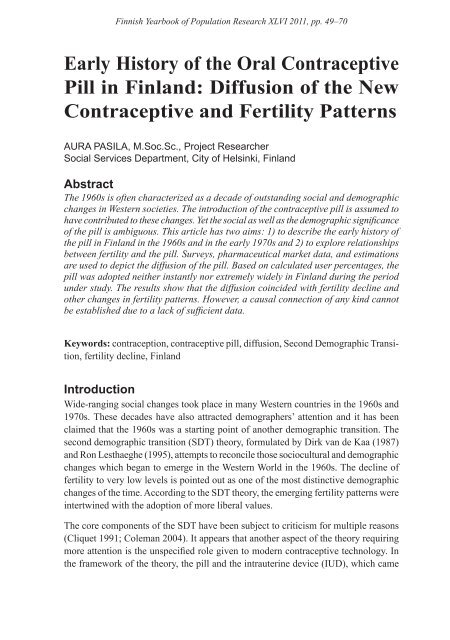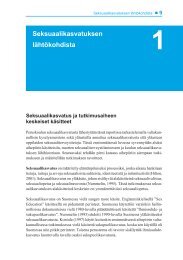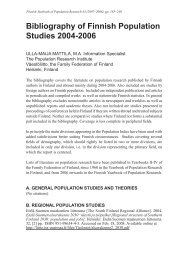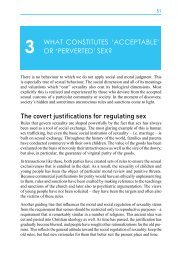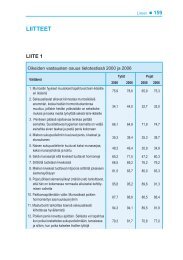Early History of the Oral Contraceptive Pill in Finland ... - Väestöliitto
Early History of the Oral Contraceptive Pill in Finland ... - Väestöliitto
Early History of the Oral Contraceptive Pill in Finland ... - Väestöliitto
Create successful ePaper yourself
Turn your PDF publications into a flip-book with our unique Google optimized e-Paper software.
F<strong>in</strong>nish Yearbook <strong>of</strong> Population Research XLVI 2011, pp. 49–70<br />
49<br />
<strong>Early</strong> <strong>History</strong> <strong>of</strong> <strong>the</strong> <strong>Oral</strong> <strong>Contraceptive</strong><br />
<strong>Pill</strong> <strong>in</strong> F<strong>in</strong>land: Diffusion <strong>of</strong> <strong>the</strong> New<br />
<strong>Contraceptive</strong> and Fertility Patterns<br />
AURA PASILA, M.Soc.Sc., Project Researcher<br />
Social Services Department, City <strong>of</strong> Hels<strong>in</strong>ki, F<strong>in</strong>land<br />
Abstract<br />
The 1960s is <strong>of</strong>ten characterized as a decade <strong>of</strong> outstand<strong>in</strong>g social and demographic<br />
changes <strong>in</strong> Western societies. The <strong>in</strong>troduction <strong>of</strong> <strong>the</strong> contraceptive pill is assumed to<br />
have contributed to <strong>the</strong>se changes. Yet <strong>the</strong> social as well as <strong>the</strong> demographic significance<br />
<strong>of</strong> <strong>the</strong> pill is ambiguous. This article has two aims: 1) to describe <strong>the</strong> early history <strong>of</strong><br />
<strong>the</strong> pill <strong>in</strong> F<strong>in</strong>land <strong>in</strong> <strong>the</strong> 1960s and <strong>in</strong> <strong>the</strong> early 1970s and 2) to explore relationships<br />
between fertility and <strong>the</strong> pill. Surveys, pharmaceutical market data, and estimations<br />
are used to depict <strong>the</strong> diffusion <strong>of</strong> <strong>the</strong> pill. Based on calculated user percentages, <strong>the</strong><br />
pill was adopted nei<strong>the</strong>r <strong>in</strong>stantly nor extremely widely <strong>in</strong> F<strong>in</strong>land dur<strong>in</strong>g <strong>the</strong> period<br />
under study. The results show that <strong>the</strong> diffusion co<strong>in</strong>cided with fertility decl<strong>in</strong>e and<br />
o<strong>the</strong>r changes <strong>in</strong> fertility patterns. However, a causal connection <strong>of</strong> any k<strong>in</strong>d cannot<br />
be established due to a lack <strong>of</strong> sufficient data.<br />
Keywords: contraception, contraceptive pill, diffusion, Second Demographic Transition,<br />
fertility decl<strong>in</strong>e, F<strong>in</strong>land<br />
Introduction<br />
Wide-rang<strong>in</strong>g social changes took place <strong>in</strong> many Western countries <strong>in</strong> <strong>the</strong> 1960s and<br />
1970s. These decades have also attracted demographers’ attention and it has been<br />
claimed that <strong>the</strong> 1960s was a start<strong>in</strong>g po<strong>in</strong>t <strong>of</strong> ano<strong>the</strong>r demographic transition. The<br />
second demographic transition (SDT) <strong>the</strong>ory, formulated by Dirk van de Kaa (1987)<br />
and Ron Lesthaeghe (1995), attempts to reconcile those sociocultural and demographic<br />
changes which began to emerge <strong>in</strong> <strong>the</strong> Western World <strong>in</strong> <strong>the</strong> 1960s. The decl<strong>in</strong>e <strong>of</strong><br />
fertility to very low levels is po<strong>in</strong>ted out as one <strong>of</strong> <strong>the</strong> most dist<strong>in</strong>ctive demographic<br />
changes <strong>of</strong> <strong>the</strong> time. Accord<strong>in</strong>g to <strong>the</strong> SDT <strong>the</strong>ory, <strong>the</strong> emerg<strong>in</strong>g fertility patterns were<br />
<strong>in</strong>tertw<strong>in</strong>ed with <strong>the</strong> adoption <strong>of</strong> more liberal values.<br />
The core components <strong>of</strong> <strong>the</strong> SDT have been subject to criticism for multiple reasons<br />
(Cliquet 1991; Coleman 2004). It appears that ano<strong>the</strong>r aspect <strong>of</strong> <strong>the</strong> <strong>the</strong>ory requir<strong>in</strong>g<br />
more attention is <strong>the</strong> unspecified role given to modern contraceptive technology. In<br />
<strong>the</strong> framework <strong>of</strong> <strong>the</strong> <strong>the</strong>ory, <strong>the</strong> pill and <strong>the</strong> <strong>in</strong>trauter<strong>in</strong>e device (IUD), which came
50<br />
to <strong>the</strong> market first <strong>in</strong> <strong>the</strong> 1960s, are considered very important technological <strong>in</strong>novations.<br />
Yet it is stated that <strong>the</strong> <strong>in</strong>troduction <strong>of</strong> <strong>the</strong> modern contraceptives was only a<br />
part <strong>of</strong> a wider change and similar type <strong>of</strong> development <strong>in</strong> fertility could have taken<br />
place <strong>in</strong> any case because <strong>of</strong> <strong>the</strong> deep transformation <strong>in</strong> people’s view <strong>of</strong> life (van de<br />
Kaa 1987, 10, 26; see Ariès 1980, 649–650). In <strong>the</strong> context <strong>of</strong> <strong>the</strong> SDT <strong>the</strong> role <strong>of</strong> <strong>the</strong><br />
contraceptive methods rema<strong>in</strong>s unclear, because no <strong>in</strong>-depth analyses have been made<br />
to scrut<strong>in</strong>ize <strong>the</strong>ir relationship to fertility.<br />
The bafflement over <strong>the</strong> significance <strong>of</strong> <strong>the</strong> modern contraceptive methods is not limited<br />
to <strong>the</strong> SDT <strong>the</strong>ory. In general, <strong>the</strong> history <strong>of</strong> modern contraceptives has not been<br />
extensively studied from a demographic po<strong>in</strong>t <strong>of</strong> view. There appears to be two reasons<br />
for this. Firstly, <strong>in</strong> <strong>the</strong> field <strong>of</strong> demographic th<strong>in</strong>k<strong>in</strong>g <strong>the</strong> motivation to limit fertility is<br />
<strong>of</strong>ten seen as <strong>the</strong> most decisive factor affect<strong>in</strong>g <strong>the</strong> number <strong>of</strong> children, whereas <strong>the</strong><br />
means available are regarded as less important. Mere <strong>in</strong>dividual determ<strong>in</strong>ation can<br />
be sufficient for fertility limitation, despite <strong>the</strong> lack <strong>of</strong> contraceptives. Evidence to<br />
support this view comes from <strong>the</strong> societies that experienced major fertility transitions<br />
<strong>in</strong> <strong>the</strong> 19 th and <strong>in</strong> <strong>the</strong> early 20 th century even though people did not usually use any<br />
contraceptives (Watk<strong>in</strong>s 1986, 435). In addition to historical examples, <strong>the</strong> very low<br />
fertility level prevail<strong>in</strong>g <strong>in</strong> present-day Japan is achieved by condoms, spermicides,<br />
<strong>the</strong> rhythm method, and abortion <strong>in</strong>stead <strong>of</strong> modern hormonal contraceptives (Hayashi<br />
2004; Leridon 2006, 604–605, 611). Thus, consider<strong>in</strong>g fertility as a purely demographic<br />
phenomenon, contraceptives can be seen to have only secondary importance.<br />
The few studies concentrat<strong>in</strong>g on <strong>the</strong> effects <strong>of</strong> <strong>the</strong> contraceptives, here <strong>in</strong> particular<br />
those <strong>of</strong> <strong>the</strong> pill, provide conflict<strong>in</strong>g results. The lack <strong>of</strong> data from <strong>the</strong> early phases <strong>of</strong><br />
<strong>the</strong> <strong>in</strong>troduction <strong>of</strong> <strong>the</strong> pill is a major factor contribut<strong>in</strong>g to <strong>the</strong> discrepancies. When<br />
<strong>the</strong> diffusion <strong>of</strong> <strong>the</strong> contraceptive pill has been studied <strong>in</strong> respect <strong>of</strong> <strong>the</strong> total fertility<br />
rate (TFR), no universal connection between <strong>the</strong> two has been found. The connection<br />
may be non-existent, weak or discont<strong>in</strong>uous (Leridon 2006). A more detailed study<br />
<strong>in</strong> Norway provides a possible explanation by conclud<strong>in</strong>g that <strong>the</strong> fertility effects <strong>of</strong><br />
<strong>the</strong> pill were negligible because it was ma<strong>in</strong>ly adopted by women who already had a<br />
low risk <strong>of</strong> pregnancy (Østby 1989, 41).<br />
In o<strong>the</strong>r studies <strong>the</strong> adoption <strong>of</strong> <strong>the</strong> pill, as well as its abandonment, has been shown<br />
to expla<strong>in</strong> changes <strong>in</strong> fertility. The most detailed quantitative studies <strong>of</strong> <strong>the</strong> pill have<br />
been carried out <strong>in</strong> <strong>the</strong> United K<strong>in</strong>gdom and <strong>in</strong> <strong>the</strong> United States where <strong>the</strong> pill diffused<br />
rapidly and widely (Leridon 2006). In Brita<strong>in</strong> <strong>the</strong> <strong>in</strong>troduction <strong>of</strong> <strong>the</strong> pill <strong>in</strong> <strong>the</strong><br />
1960s made many women switch to a more effective contraception method. The share<br />
<strong>of</strong> women us<strong>in</strong>g contraception also <strong>in</strong>creased slightly. The TFR decl<strong>in</strong>ed <strong>in</strong> l<strong>in</strong>e with<br />
<strong>the</strong> diffusion <strong>of</strong> <strong>the</strong> pill. However, after two pill ‘scares’ caused by <strong>the</strong> publicity <strong>of</strong> its<br />
negative health effects, <strong>the</strong> growth <strong>in</strong> sales first stagnated and later decreased. In <strong>the</strong><br />
latter case a rise <strong>in</strong> <strong>the</strong> TFR resulted (Murphy 1993).
51<br />
In <strong>the</strong> United States it has been possible to complete multiple analyses on <strong>the</strong> relationships<br />
between young women’s fertility-related behavior, fertility, and <strong>the</strong> pill. They<br />
are based on <strong>the</strong> differential tim<strong>in</strong>g <strong>of</strong> <strong>the</strong> availability <strong>of</strong> <strong>the</strong> pill <strong>in</strong> <strong>the</strong> states. The<br />
studies show that <strong>the</strong> adoption <strong>of</strong> <strong>the</strong> pill postponed young women’s marriage. It also<br />
postponed <strong>the</strong> beg<strong>in</strong>n<strong>in</strong>g <strong>of</strong> childbear<strong>in</strong>g and lowered birth rates. Women’s lifetime<br />
fertility appears to have decl<strong>in</strong>ed as well due to access to <strong>the</strong> pill (Ananat & Hungerman<br />
2007; Bailey 2006; Gold<strong>in</strong> & Katz 2002; Guldi 2008).<br />
The studies suggest that <strong>the</strong> contraception method adopted and used can have demographic<br />
significance <strong>in</strong> terms <strong>of</strong> fertility. However, <strong>the</strong> results obta<strong>in</strong>ed so far are<br />
<strong>in</strong>consistent, and fur<strong>the</strong>r research on <strong>the</strong> relationship between <strong>the</strong> modern contraceptives<br />
and <strong>the</strong> changes <strong>in</strong> fertility patterns is necessary. On <strong>the</strong> one hand, <strong>the</strong>re are<br />
sociological and <strong>in</strong>dividual level psychological questions such as why people choose<br />
to control <strong>the</strong>ir fertility by us<strong>in</strong>g certa<strong>in</strong> methods and not o<strong>the</strong>rs or why <strong>the</strong>y decide to<br />
adopt a new method. And on <strong>the</strong> o<strong>the</strong>r hand, <strong>the</strong>re are demographic questions such as<br />
what happens to people’s fertility when a new method is <strong>in</strong>troduced or what k<strong>in</strong>ds <strong>of</strong><br />
relationships prevail between vary<strong>in</strong>g levels <strong>of</strong> contraceptive use, different contraceptive<br />
method mixes, and fertility patterns. Ideally, <strong>the</strong> viewpo<strong>in</strong>ts are brought toge<strong>the</strong>r.<br />
A sociological depiction <strong>of</strong> social and cultural context <strong>of</strong> fertility limitation could<br />
be comb<strong>in</strong>ed with quantitative fertility analysis. In this way it would be possible to<br />
estimate <strong>the</strong> effect <strong>of</strong> <strong>the</strong> contraceptive and specify <strong>the</strong> mechanism by which a certa<strong>in</strong><br />
fertility effect was generated – or why no effect was generated.<br />
This article pursues clarification for some <strong>of</strong> <strong>the</strong> questions above by comb<strong>in</strong><strong>in</strong>g a<br />
sociological and a demographic perspective. In addition, <strong>the</strong> article will describe <strong>the</strong><br />
early history <strong>of</strong> <strong>the</strong> pill <strong>in</strong> F<strong>in</strong>land. The focus will be on <strong>the</strong> diffusion <strong>of</strong> <strong>the</strong> pill and its<br />
relationships with fertility patterns. When, how, and by whom was <strong>the</strong> pill adopted?<br />
What happened to fertility after <strong>the</strong> <strong>in</strong>troduction <strong>of</strong> <strong>the</strong> pill? The case <strong>of</strong> F<strong>in</strong>land is<br />
quite different from that <strong>of</strong> <strong>the</strong> United States, for example, because <strong>the</strong> availability <strong>of</strong><br />
<strong>the</strong> pill or modern contraceptives <strong>in</strong> general has been <strong>in</strong>tertw<strong>in</strong>ed with <strong>the</strong> construction<br />
<strong>of</strong> <strong>the</strong> extensive welfare state and its healthcare services.<br />
A <strong>the</strong>oretical approach on <strong>the</strong> role <strong>of</strong> contraceptives<br />
The general <strong>the</strong>oretical framework <strong>of</strong> this article comes from <strong>the</strong> second demographic<br />
transition <strong>the</strong>ory. The <strong>the</strong>ory suggests that whereas <strong>the</strong> first demographic transition<br />
was conditioned by decl<strong>in</strong>es <strong>in</strong> mortality, <strong>the</strong> changes <strong>in</strong> fertility patterns emerg<strong>in</strong>g<br />
<strong>in</strong> Western <strong>in</strong>dustrialized countries from <strong>the</strong> early 1960s onwards are related to <strong>the</strong><br />
diffusion <strong>of</strong> new values emphasiz<strong>in</strong>g autonomy, <strong>in</strong>dividualism, and self-fulfillment<br />
(van de Kaa 1987; Lesthaeghe 1995). The <strong>the</strong>ory is strongly based on Philippe Ariès’<br />
ideas (van de Kaa 2002, 4).
52<br />
Ariès (1980) separated two different views on life and <strong>of</strong>fspr<strong>in</strong>g beh<strong>in</strong>d <strong>the</strong> fertility<br />
decl<strong>in</strong>es. The parents’ concern to guarantee a good social and economic position for<br />
<strong>the</strong>ir children was a major motivational factor responsible for <strong>the</strong> first decl<strong>in</strong>e. But<br />
as <strong>the</strong> liv<strong>in</strong>g standards rose quickly after <strong>the</strong> Second World War, adults became more<br />
<strong>in</strong>terested <strong>in</strong> pursu<strong>in</strong>g <strong>the</strong>ir own <strong>in</strong>dividual goals and self-fulfillment. Simultaneously<br />
<strong>the</strong>ir <strong>in</strong>terest <strong>in</strong> <strong>the</strong>ir children’s future became less central. Modern contraception<br />
technology was an <strong>in</strong>dication <strong>of</strong> this changed mentality, but accord<strong>in</strong>g to Ariès (ibid.,<br />
649–650) it did not cause <strong>the</strong> changes. Ariès’ views on <strong>the</strong> modern contraceptives have<br />
been reflected <strong>in</strong> <strong>the</strong> SDT <strong>the</strong>ory. The new contraceptive methods are by no means<br />
considered <strong>in</strong>significant, but much more emphasis is placed on <strong>the</strong> cultural change<br />
that accompanied <strong>the</strong>ir <strong>in</strong>troduction. Modern contraceptives <strong>in</strong>creased <strong>the</strong> freedom<br />
<strong>of</strong> choice and made more complete fertility control possible. They were not just an<br />
<strong>in</strong>dication <strong>of</strong> <strong>the</strong> change but also facilitated it (van de Kaa 1997).<br />
The conclusions on <strong>the</strong> role <strong>of</strong> contraceptives dur<strong>in</strong>g <strong>the</strong> fertility decl<strong>in</strong>e are not based<br />
on <strong>in</strong>-depth analysis. In order to explore <strong>the</strong> role <strong>of</strong> contraceptives more extensively,<br />
it is necessary to use a model <strong>of</strong> fertility behavior <strong>in</strong>to which <strong>the</strong> two-way <strong>in</strong>teraction<br />
between fertility patterns and <strong>the</strong> attributes <strong>of</strong> <strong>the</strong> new contraceptive methods <strong>in</strong> a<br />
specific context are <strong>in</strong>corporated (see Murphy 1993, 240). The significance <strong>of</strong> <strong>the</strong> different<br />
contraceptives can be outl<strong>in</strong>ed <strong>in</strong> this way by us<strong>in</strong>g Richard Easterl<strong>in</strong>’s (1975)<br />
reformulation <strong>of</strong> <strong>the</strong> microeconomic <strong>the</strong>ory <strong>of</strong> fertility.<br />
Easterl<strong>in</strong> (ibid.) considers <strong>the</strong> balance between <strong>the</strong> demand and <strong>the</strong> supply <strong>of</strong> children<br />
<strong>in</strong> order to clarify <strong>the</strong> factors beh<strong>in</strong>d a certa<strong>in</strong> level <strong>of</strong> fertility. In addition to this, he<br />
takes <strong>in</strong>to account <strong>the</strong> costs <strong>of</strong> fertility control, which affect <strong>the</strong> total fertility equilibrium.<br />
If <strong>the</strong> supply <strong>of</strong> children is higher than <strong>the</strong>ir demand, <strong>the</strong> chang<strong>in</strong>g level <strong>of</strong><br />
fertility control costs has a decisive effect on people’s fertility behavior. The costs<br />
may be economic or psychic. The psychic costs depend on <strong>the</strong> attitudes prevail<strong>in</strong>g <strong>in</strong><br />
<strong>the</strong> social context, on <strong>the</strong> personal views related to contraception, and on <strong>the</strong> views<br />
on a specific method. In addition, <strong>the</strong> <strong>in</strong>formation on contraception techniques and on<br />
different methods, <strong>the</strong> availability <strong>of</strong> contraceptives, <strong>the</strong> prices <strong>of</strong> methods, and <strong>the</strong><br />
selection <strong>of</strong> methods affect <strong>the</strong> perceived costs <strong>of</strong> fertility control. The <strong>in</strong>troduction <strong>of</strong><br />
<strong>the</strong> pill brought new k<strong>in</strong>ds <strong>of</strong> costs and benefits related to <strong>the</strong> fertility control (ibid.;<br />
Easterl<strong>in</strong> & Crimm<strong>in</strong>s 1985).<br />
As Easterl<strong>in</strong>’s (1975) framework is comb<strong>in</strong>ed with <strong>the</strong> SDT <strong>the</strong>ory, it can be assumed<br />
that, due to <strong>the</strong> adoption <strong>of</strong> new values, <strong>the</strong> demand for children decreased. Simultaneously<br />
<strong>the</strong>ir supply rema<strong>in</strong>ed at <strong>the</strong> same level as before. The <strong>in</strong>troduction <strong>of</strong> modern<br />
contraceptives could have decreased <strong>the</strong> costs <strong>of</strong> fertility plann<strong>in</strong>g, thus eas<strong>in</strong>g <strong>the</strong><br />
fertility control needed. Consider<strong>in</strong>g <strong>the</strong> pill, <strong>the</strong> most dist<strong>in</strong>ctive novelties were its<br />
strong connection with medic<strong>in</strong>e and <strong>the</strong> wide acceptance given to it by doctors. The<br />
approval and control by <strong>the</strong> medical pr<strong>of</strong>essionals both <strong>in</strong>creased and decreased <strong>the</strong>
53<br />
economic and psychic costs <strong>of</strong> fertility limitation, depend<strong>in</strong>g on <strong>the</strong> viewpo<strong>in</strong>t (Marks<br />
2001, 116–117; Watk<strong>in</strong>s 1998, 131). On <strong>the</strong> o<strong>the</strong>r hand, it is possible that <strong>the</strong> ease <strong>of</strong><br />
use <strong>of</strong> <strong>the</strong> new <strong>in</strong>novative contraceptives was <strong>the</strong> propell<strong>in</strong>g factor <strong>of</strong> fertility decl<strong>in</strong>e<br />
chang<strong>in</strong>g <strong>the</strong> balance between <strong>the</strong> demand and supply. It will be assessed <strong>in</strong> this paper,<br />
which one is <strong>the</strong> most likely scenario.<br />
When study<strong>in</strong>g <strong>the</strong> pill adoption <strong>in</strong> its contemporary context, <strong>the</strong> <strong>the</strong>ory <strong>of</strong> <strong>the</strong> diffusion<br />
<strong>of</strong> <strong>in</strong>novations provides useful concepts to analyze <strong>the</strong> process. The diffusion is presented<br />
to be conditional on multiple factors, such as <strong>the</strong> structure <strong>of</strong> <strong>the</strong> social system under<br />
study. However, accord<strong>in</strong>g to <strong>the</strong> <strong>the</strong>ory <strong>the</strong>re are certa<strong>in</strong> general diffusion patterns.<br />
People can be divided <strong>in</strong>to five groups <strong>in</strong> terms <strong>of</strong> <strong>the</strong> pace <strong>of</strong> <strong>in</strong>novation adoption: <strong>in</strong>novators,<br />
early adopters, early majority, late majority, and laggards. Those who adopt<br />
<strong>the</strong> <strong>in</strong>novation early are <strong>of</strong>ten more venturesome than o<strong>the</strong>rs. They have usually more<br />
f<strong>in</strong>ancial resources and better cognitive skills than do later adopters. Also <strong>the</strong> <strong>in</strong>novation<br />
itself has qualities that ei<strong>the</strong>r help it to diffuse or make <strong>the</strong> diffusion more difficult.<br />
These characteristics can be related to its perceived benefits when it is compared with<br />
preced<strong>in</strong>g solutions. The compatibility <strong>of</strong> an <strong>in</strong>novation with values, beliefs, preced<strong>in</strong>g<br />
ideas, perceived needs, its ease <strong>of</strong> use, trialability, and observable results are also<br />
important factors affect<strong>in</strong>g <strong>the</strong> diffusion process (Rogers 2003). These ideas can be<br />
taken advantage <strong>of</strong> when study<strong>in</strong>g <strong>the</strong> pace <strong>of</strong> <strong>the</strong> pill diffusion and its first users.<br />
A short history <strong>of</strong> fertility control <strong>in</strong> F<strong>in</strong>land<br />
Before proceed<strong>in</strong>g to <strong>the</strong> history <strong>of</strong> <strong>the</strong> pill it is worthwhile to exam<strong>in</strong>e briefly <strong>the</strong><br />
general history <strong>of</strong> fertility limitation <strong>in</strong> F<strong>in</strong>land. Deliberate fertility limitation became<br />
widespread <strong>in</strong> Europe dur<strong>in</strong>g <strong>the</strong> (first) demographic transition <strong>in</strong> <strong>the</strong> 19 th and early 20 th<br />
century. In F<strong>in</strong>land <strong>the</strong> transition began approximately <strong>in</strong> 1910. Compared to Western<br />
Europe <strong>the</strong> tim<strong>in</strong>g was quite late (Knodel & van de Walle 1986, 394–395). Despite<br />
<strong>the</strong> transition, public attitudes towards fertility control rema<strong>in</strong>ed negative well <strong>in</strong>to<br />
<strong>the</strong> 20 th century (Sievers, Koskela<strong>in</strong>en & Leppo 1974, 398).<br />
One factor affect<strong>in</strong>g <strong>the</strong> decl<strong>in</strong>e <strong>of</strong> <strong>the</strong> TFR was <strong>the</strong> grow<strong>in</strong>g proportion <strong>of</strong> non-married<br />
people, but also those engaged <strong>in</strong> sexual relationships changed <strong>the</strong>ir behavior (Lutz<br />
1987, 470–471; Pitkänen 2003). People relied on abst<strong>in</strong>ence, coitus <strong>in</strong>terruptus, and<br />
abortions for controll<strong>in</strong>g <strong>the</strong>ir fertility. Breastfeed<strong>in</strong>g may also have had some significance<br />
<strong>in</strong> limit<strong>in</strong>g <strong>the</strong> number <strong>of</strong> children. In addition, condoms and o<strong>the</strong>r mechanical<br />
contraceptives were sold and used to a small extent from <strong>the</strong> late 19 th century onwards,<br />
but <strong>the</strong>y were probably difficult to obta<strong>in</strong> for <strong>the</strong> majority <strong>of</strong> people and <strong>the</strong>ir efficiency<br />
was questionable (Pitkänen 2003, 202, 205–206; Ritamies 2006, 176–183).<br />
Decl<strong>in</strong><strong>in</strong>g fertility attracted a lot <strong>of</strong> attention <strong>in</strong> F<strong>in</strong>land. The predom<strong>in</strong>ant public op<strong>in</strong>ion<br />
was strongly pronatalistic (Pitkänen 1988, 55). Anxiety reached its peak <strong>in</strong> <strong>the</strong> 1930s.<br />
At that time <strong>the</strong> TFR had dropped to low levels – its lowest be<strong>in</strong>g 2.27 <strong>in</strong> 1933 – and
54<br />
nationalistic worries surged (Statistics F<strong>in</strong>land 2011b). Contraception and especially<br />
abortion were usually criticized because <strong>the</strong>y were considered unbeneficial for <strong>the</strong><br />
nation (see Meskus 2003). However, despite <strong>the</strong> public condemnation, contraception<br />
was never legally abolished <strong>in</strong> F<strong>in</strong>land (Pitkänen 2003, 194).<br />
Instead <strong>of</strong> prohibit<strong>in</strong>g contraceptives, o<strong>the</strong>r measures were taken to avert depopulation.<br />
Legislative <strong>in</strong>itiatives were channeled <strong>in</strong>to support<strong>in</strong>g families (Pitkänen 1988, 69).<br />
In addition, Väestöliitto r.y., <strong>the</strong> F<strong>in</strong>nish Population and Family Welfare Federation<br />
(FPFWF, now <strong>the</strong> Family Federation), was founded <strong>in</strong> 1941. It was and has cont<strong>in</strong>ued<br />
to be a central <strong>in</strong>stitute <strong>in</strong> shap<strong>in</strong>g and fulfill<strong>in</strong>g political goals related to reproduction,<br />
fertility control, and sexuality. The FPFWF was supported by <strong>the</strong> state but it did not<br />
work under any department <strong>of</strong> government. From 1947 onwards one <strong>of</strong> <strong>the</strong> tasks <strong>of</strong><br />
<strong>the</strong> FPFWF was to give counsel<strong>in</strong>g related to sexual problems and family plann<strong>in</strong>g for<br />
people who were gett<strong>in</strong>g married or were already married (Rauttamo 1980). In addition<br />
to family plann<strong>in</strong>g work, <strong>the</strong> FPFWF soon got ano<strong>the</strong>r closely related task. After <strong>the</strong><br />
Act on Induced Abortion (82/1950) came <strong>in</strong>to force – legaliz<strong>in</strong>g abortion for medical<br />
reasons – <strong>the</strong> FPFWF started to work on prevent<strong>in</strong>g abortions (Rauttamo 1980, 64).<br />
The family plann<strong>in</strong>g counsel<strong>in</strong>g may appear to be <strong>in</strong> conflict with pronatalistic goals,<br />
but <strong>in</strong> <strong>the</strong> beg<strong>in</strong>n<strong>in</strong>g it was expected that <strong>the</strong> possibility to conceive children at more<br />
suitable times would <strong>in</strong>crease <strong>the</strong> total number <strong>of</strong> children per family. The ma<strong>in</strong><br />
methods recommended by <strong>the</strong> doctors work<strong>in</strong>g at <strong>the</strong> FPFWF were spermicide and<br />
<strong>the</strong> diaphragm. Despite <strong>the</strong> pioneer<strong>in</strong>g work done by <strong>the</strong> FPFWF <strong>in</strong> <strong>the</strong> field <strong>of</strong> contraception,<br />
<strong>the</strong> contraceptives <strong>of</strong>fered by <strong>the</strong> medical pr<strong>of</strong>essionals were not widely used.<br />
Fur<strong>the</strong>rmore, doctors outside <strong>the</strong> FPFWF were not very eager to <strong>in</strong>clude contraception<br />
<strong>in</strong> <strong>the</strong>ir medical duties (Helén 1997, 241–242, 251, 255; Ritamies 2006, 196–197;<br />
Sievers et al. 1974, 409). In addition to <strong>the</strong>ir attitudes medical pr<strong>of</strong>essionals did not<br />
necessarily have <strong>the</strong> education needed to provide contraceptives (Palolampi & Leppo<br />
1966, 56–57, 61). Thus, <strong>in</strong> <strong>the</strong> 1940s and 1950s it was still quite common that children<br />
were born without much plann<strong>in</strong>g (Nätk<strong>in</strong> 1994, 137).<br />
Pronatalistic currents faded by <strong>the</strong> end <strong>of</strong> <strong>the</strong> 1950s, both <strong>in</strong> <strong>the</strong> work done by <strong>the</strong><br />
FPFWF and <strong>in</strong> <strong>the</strong> public discussion. A temporary peak <strong>in</strong> <strong>the</strong> TFR took place after<br />
<strong>the</strong> war years <strong>in</strong> <strong>the</strong> 1940s, but <strong>the</strong> follow<strong>in</strong>g decl<strong>in</strong>e did not any more cause extensive<br />
public anxiety. A new political atmosphere emphasized families’ perspective<br />
and to some extent also that <strong>of</strong> <strong>the</strong> <strong>in</strong>dividual family members. The change was not<br />
as sudden and radical as it might appear here s<strong>in</strong>ce, despite <strong>the</strong> shift <strong>in</strong> <strong>the</strong> viewpo<strong>in</strong>t<br />
from population to family, <strong>the</strong> spheres <strong>of</strong> sexuality and reproduction were still targets<br />
<strong>of</strong> public control and guidance (Helén 1997, 233–238; Pitkänen 1988, 70; Statistics<br />
F<strong>in</strong>land 2011b).
55<br />
The <strong>in</strong>troduction <strong>of</strong> <strong>the</strong> pill<br />
The oral contraceptive pill was developed <strong>in</strong> <strong>the</strong> United States. Searle’s Enovid was<br />
accepted and <strong>in</strong>troduced <strong>in</strong>to <strong>the</strong> market as a contraceptive <strong>in</strong> 1960 (Reed 1978, 364).<br />
With<strong>in</strong> a few years, <strong>the</strong> pill diffused <strong>in</strong>to <strong>the</strong> English-speak<strong>in</strong>g countries and Europe<br />
(Marks 2001, 183–185). In F<strong>in</strong>land, <strong>the</strong> first pill was <strong>in</strong>troduced <strong>in</strong>to <strong>the</strong> market <strong>in</strong><br />
1962 (Suomen tieteen historia 2000, 585). However, <strong>the</strong> first pill trials were already<br />
<strong>in</strong>itiated by <strong>the</strong> FPFWF <strong>in</strong> 1961 (Väestöliitto 1961).<br />
Even though <strong>the</strong> pill had received <strong>the</strong> approval <strong>of</strong> <strong>the</strong> Food and Drug Adm<strong>in</strong>istration <strong>in</strong><br />
<strong>the</strong> United States before enter<strong>in</strong>g <strong>the</strong> market, F<strong>in</strong>nish doctors approached it cautiously<br />
(Reed 1978, 364; Warpenius 1997, 53–58). As <strong>the</strong> FPFWF ruled <strong>in</strong> <strong>the</strong> field <strong>of</strong> family<br />
plann<strong>in</strong>g <strong>in</strong> <strong>the</strong> 1960s, its doctors scrut<strong>in</strong>ized <strong>the</strong> pill carefully (Helén 1997, 249;<br />
e.g. Väestöliitto 1961). Despite <strong>the</strong> early caution, <strong>the</strong> pill was quickly accepted <strong>in</strong> <strong>the</strong><br />
FPFWF (Turpe<strong>in</strong>en 1967, 13). However, this happened <strong>in</strong>side <strong>the</strong> framework <strong>of</strong> <strong>the</strong><br />
counsel<strong>in</strong>g work <strong>of</strong> <strong>the</strong> FPFWF. The approval did not lead <strong>in</strong>to a situation <strong>in</strong> which<br />
<strong>the</strong> pill would have been freely <strong>of</strong>fered to everyone (Helén 1997, 250).<br />
The lack <strong>of</strong> access to reliable contraception was one <strong>of</strong> <strong>the</strong> ma<strong>in</strong> <strong>the</strong>mes <strong>in</strong> <strong>the</strong> sexual<br />
debate which broke out <strong>in</strong> 1965. The debate echoed similar discussions <strong>in</strong> o<strong>the</strong>r<br />
Western countries. It was <strong>in</strong>itiated by students, <strong>in</strong> F<strong>in</strong>land especially by <strong>the</strong> students<br />
<strong>of</strong> medic<strong>in</strong>e. The church, <strong>the</strong> educational authorities, doctors, and <strong>the</strong> FPFWF were<br />
all blamed for <strong>the</strong>ir conservative attitudes towards sexuality. The critics claimed that<br />
<strong>the</strong> prevail<strong>in</strong>g views resulted <strong>in</strong> ignorance on sexuality and contraception, which, for<br />
example, caused illegal abortions to soar (see Taipale 1966).<br />
The F<strong>in</strong>nish women’s movement was also reviv<strong>in</strong>g <strong>in</strong> <strong>the</strong> mid-1960s. Yhdistys 9, The<br />
Equality Movement Association 9, campaigned, among o<strong>the</strong>r th<strong>in</strong>gs, for <strong>the</strong> better<br />
availability <strong>of</strong> contraceptives <strong>in</strong> order to <strong>in</strong>crease a woman’s freedom to pursue sexual<br />
self-fulfillment (Jall<strong>in</strong>oja 1983, 128, 158, 172, 252). Some level <strong>of</strong> fertility control was<br />
also a precondition for a woman’s chances to work outside <strong>the</strong> home (Julkunen 1994,<br />
191). In F<strong>in</strong>land <strong>the</strong> proportion <strong>of</strong> work<strong>in</strong>g married women had started to grow <strong>in</strong> <strong>the</strong><br />
urban areas <strong>in</strong> <strong>the</strong> 1950s. Women <strong>in</strong>creas<strong>in</strong>gly entered higher education and work<strong>in</strong>g<br />
life <strong>in</strong> <strong>the</strong> 1960s and 1970s (Hulkko 1979, 22; Jall<strong>in</strong>oja 1980, 234–235).<br />
The public discussion from <strong>the</strong> mid-1960s onwards reflects <strong>the</strong> changed attitudes <strong>in</strong><br />
F<strong>in</strong>nish society. As <strong>the</strong> SDT <strong>the</strong>ory suggests, new values adopted were more liberal<br />
and <strong>in</strong>dividualistic than <strong>the</strong> preced<strong>in</strong>g ones. Correspond<strong>in</strong>g changes occurred also <strong>in</strong><br />
family formation. In <strong>the</strong> early 1960s people still married young – <strong>in</strong> 1961–1965 <strong>the</strong><br />
median age for a first marriage was 22.3 years for women and 24.1 for men – and <strong>the</strong><br />
marriage rates were high. However, <strong>the</strong> number <strong>of</strong> divorces had already started to rise.<br />
Both <strong>the</strong> number <strong>of</strong> new marriages and <strong>the</strong> marriage rate began to decl<strong>in</strong>e from <strong>the</strong><br />
early 1970s onwards. Dur<strong>in</strong>g <strong>the</strong> 1970s marriage started to shift to be later as well: <strong>in</strong>
56<br />
1976–1980 <strong>the</strong> median age for women enter<strong>in</strong>g <strong>the</strong>ir first marriage had risen to 23.3<br />
years and 25.2 for men. Simultaneously cohabitation was becom<strong>in</strong>g <strong>in</strong>creas<strong>in</strong>gly<br />
popular (L<strong>in</strong>dgren 1979; Miett<strong>in</strong>en 2005, 194; Statistics F<strong>in</strong>land 1967b, 53; Statistics<br />
F<strong>in</strong>land 1978, 60–62; see also van de Kaa 1997, 10).<br />
It is specific for <strong>the</strong> F<strong>in</strong>nish context that <strong>the</strong> proponents <strong>of</strong> <strong>the</strong> new values emphasized<br />
<strong>the</strong> role and <strong>the</strong> activity <strong>of</strong> <strong>the</strong> state <strong>in</strong> ensur<strong>in</strong>g that <strong>the</strong>ir goals could be met. They set<br />
various responsibilities for <strong>the</strong> public sector related to such fields as education and<br />
health (Taipale 1966). The discussion on gender roles, sexuality, and contraception<br />
began to turn <strong>in</strong>to actions at <strong>the</strong> beg<strong>in</strong>n<strong>in</strong>g <strong>of</strong> <strong>the</strong> 1970s. Many <strong>of</strong> <strong>the</strong> aims orig<strong>in</strong>ally<br />
formulated by <strong>the</strong> social movements had become objectives <strong>of</strong> <strong>the</strong> ris<strong>in</strong>g welfare state.<br />
As mentioned, dur<strong>in</strong>g <strong>the</strong> 20 th century <strong>in</strong>dividual’s reproductive potential had been first<br />
viewed ma<strong>in</strong>ly from <strong>the</strong> perspective <strong>of</strong> <strong>the</strong> population and <strong>the</strong> nation, <strong>the</strong>n from <strong>the</strong><br />
viewpo<strong>in</strong>t <strong>of</strong> <strong>the</strong> family. In <strong>the</strong> third phase, more attention was given to <strong>the</strong> <strong>in</strong>dividual<br />
and his or her <strong>in</strong>dividual wants and needs. Sexuality and <strong>the</strong> control <strong>of</strong> reproduction<br />
became <strong>in</strong>creas<strong>in</strong>gly viewed as important <strong>in</strong>dividual rights, which <strong>the</strong> state was assumed<br />
to guarantee and promote (Helén & Yesilova 2003, 245–248). This also meant that <strong>the</strong><br />
authorities were assumed to provide <strong>the</strong> services needed <strong>in</strong>stead <strong>of</strong> non-governmental<br />
organizations (Ritamies 2006, 255).<br />
Medical pr<strong>of</strong>essionals were at <strong>the</strong> center <strong>of</strong> <strong>the</strong> changes related to fertility control. In<br />
approximately one decade a notable attitud<strong>in</strong>al shift took place among F<strong>in</strong>nish doctors.<br />
Many <strong>of</strong> <strong>the</strong>m had adopted a ra<strong>the</strong>r liberal stance towards contraception by <strong>the</strong><br />
end <strong>of</strong> <strong>the</strong> 1960s though still <strong>in</strong> 1968 doctors were more <strong>of</strong>ten will<strong>in</strong>g to give family<br />
plann<strong>in</strong>g counsel<strong>in</strong>g when asked by married women (n<strong>in</strong>e out <strong>of</strong> ten) than by those<br />
who were not married (two out or three). From <strong>the</strong> different methods available, <strong>the</strong><br />
doctors already preferred <strong>the</strong> pill (Turpe<strong>in</strong>en 1968; Warpenius 1997). By <strong>the</strong> mid-1970s<br />
an <strong>in</strong>dividual’s right to family plann<strong>in</strong>g counsel<strong>in</strong>g and to abortion had been consolidated<br />
<strong>in</strong> laws. The new Act on Induced Abortion (239/1970) – <strong>in</strong> which abortion was<br />
legalized on social grounds – and <strong>the</strong> Primary Health Care Act (66/1972) established<br />
<strong>the</strong> practices <strong>in</strong>to <strong>the</strong> health care system <strong>of</strong> <strong>the</strong> welfare state. Both <strong>of</strong> <strong>the</strong>se practices<br />
had become thoroughly medicalized.<br />
When <strong>the</strong> Act on Induced Abortion (239/1970) came <strong>in</strong>to force, <strong>the</strong> amount <strong>of</strong> legal<br />
abortions rose substantially. In 1973 more than 23,000 abortions were recorded (Stakes<br />
2004). For comparison, <strong>in</strong> <strong>the</strong> same year <strong>the</strong> number <strong>of</strong> births was slightly below<br />
57,000 (Statistics F<strong>in</strong>land 2011a). The rapid rise <strong>in</strong> abortion rates paved <strong>the</strong> way for<br />
<strong>the</strong> <strong>in</strong>troduction <strong>of</strong> a law on contraception services. The activists <strong>of</strong> social movements,<br />
<strong>the</strong> FPFWF, authorities, and doctors were all able to agree that contraception was a<br />
better and more acceptable way to limit fertility than abortion. However, no separate<br />
law on contraception was ever enacted. Instead, contraception counsel<strong>in</strong>g was <strong>in</strong>cluded<br />
<strong>in</strong> <strong>the</strong> Primary Health Care Act (66/1972) aimed to renew patchy primary health care.
57<br />
The responsibility to <strong>of</strong>fer <strong>in</strong>formation on contraception and contraceptives for all<br />
residents <strong>of</strong> <strong>the</strong> municipality was given to <strong>the</strong> municipal health centers. In <strong>the</strong> health<br />
centers general practitioners and public health nurses performed <strong>the</strong> practical work<br />
(ibid.; Helén 1997, 249; Helén & Yesilova 2003, 246–247; Kosunen & Rimpelä 1997,<br />
1199; R<strong>in</strong>tala 1995, 58–59; Warpenius 1997, 66–67).<br />
The follow<strong>in</strong>g extensive availability <strong>of</strong> <strong>the</strong> pill was closely related to doctors’ approval<br />
<strong>of</strong> <strong>the</strong> pill and <strong>of</strong> contraception more generally. One important factor contribut<strong>in</strong>g to<br />
this was that <strong>the</strong> pill itself is a medical contraceptive. Doctors became more able to<br />
use <strong>the</strong>ir expertise <strong>in</strong> <strong>the</strong> field <strong>of</strong> fertility control. As <strong>in</strong> <strong>the</strong> United States, <strong>the</strong> ease <strong>of</strong><br />
writ<strong>in</strong>g a prescription, compared with diaphragm fitt<strong>in</strong>g as performed earlier by some<br />
doctors, was probably also an advantage (Marks 2001, 121; Watk<strong>in</strong>s 1998, 34–35).<br />
Simultaneously <strong>the</strong> change <strong>of</strong> generation was tak<strong>in</strong>g place among <strong>the</strong> F<strong>in</strong>nish doctors<br />
and <strong>the</strong> share <strong>of</strong> female doctors was <strong>in</strong>creas<strong>in</strong>g, perhaps result<strong>in</strong>g <strong>in</strong> more liberal attitudes<br />
(Riska 1987, 113; Suomen Lääkäriliitto 1972, 1428). For doctors, provid<strong>in</strong>g<br />
contraception was probably one way to reassert <strong>the</strong>ir position with<strong>in</strong> <strong>the</strong> health care<br />
system. As stated, contraception was also seen as a response to high abortion rates.<br />
The change <strong>in</strong> <strong>the</strong> doctors’ attitudes has been studied <strong>in</strong> detail by Katari<strong>in</strong>a Warpenius<br />
(1997).<br />
The diffusion <strong>of</strong> <strong>the</strong> pill and fertility patterns<br />
Study<strong>in</strong>g <strong>the</strong> diffusion <strong>of</strong> <strong>the</strong> pill between 1962 and mid-1970s quantitatively is challeng<strong>in</strong>g<br />
s<strong>in</strong>ce <strong>the</strong>re is hardly any numerical data available: this applies to <strong>the</strong> use <strong>of</strong><br />
contraception <strong>in</strong> general as well. The first large-scale survey on topics related to sexuality<br />
and reproductive health was not completed until <strong>in</strong> 1971 (Sievers et al. 1974).<br />
Thus, <strong>the</strong> <strong>in</strong>formation on <strong>the</strong> use <strong>of</strong> pill <strong>in</strong> <strong>the</strong> 1960s is based on fragmentary data and<br />
estimations. The data used here is presented <strong>in</strong> Figures 1 and 2. In Figure 1, <strong>the</strong> changes<br />
<strong>in</strong> <strong>the</strong> number <strong>of</strong> <strong>the</strong> pill brands on <strong>the</strong> market are considered as <strong>in</strong>direct <strong>in</strong>dicators <strong>of</strong><br />
<strong>the</strong> trends <strong>in</strong> <strong>the</strong> use <strong>of</strong> <strong>the</strong> pill. The idea is that it would not have been pr<strong>of</strong>itable for <strong>the</strong><br />
drug companies to keep <strong>the</strong>ir products on <strong>the</strong> market very long without user demand.<br />
In Figure 2, data on <strong>the</strong> use <strong>of</strong> <strong>the</strong> pill and previous research results are comb<strong>in</strong>ed<br />
and transformed <strong>in</strong>to <strong>the</strong> percentage <strong>of</strong> women us<strong>in</strong>g <strong>the</strong> pill dur<strong>in</strong>g 1960–1976. The<br />
change <strong>in</strong> <strong>the</strong> percentages is tentatively represented <strong>in</strong> respect <strong>of</strong> <strong>the</strong> TFR.
58<br />
N<br />
35<br />
30<br />
25<br />
20<br />
15<br />
10<br />
5<br />
0<br />
1962 1963* 1964 1965 1966 1967 1968 1969 1970 1971 1972 1973 1974 1975 1976<br />
Comb<strong>in</strong>ed pill Sequential pill Progest<strong>in</strong> pill<br />
Figure 1. The number <strong>of</strong> <strong>the</strong> available pill brands accord<strong>in</strong>g to <strong>the</strong> type <strong>of</strong> preparation<br />
<strong>in</strong> F<strong>in</strong>land dur<strong>in</strong>g 1962–1976.<br />
Source: He<strong>in</strong>onen 1962; 1964–1969b; 1971–1972b; 1974a–1974b; 1975.<br />
Note 1: * = No <strong>in</strong>formation available for 1963.<br />
Note 2: Hormonal preparation Sarena is not <strong>in</strong>cluded <strong>in</strong> <strong>the</strong> figures for 1969 because, even though it was listed among<br />
oral contraceptive pills, it was used to treat menopause.<br />
Figure 1 is based on <strong>the</strong> <strong>in</strong>formation given <strong>in</strong> <strong>the</strong> F<strong>in</strong>nish drug catalogues called Remedia<br />
Fennica (see He<strong>in</strong>onen 1962). As can be seen <strong>in</strong> Figure 1, <strong>the</strong> first pills <strong>in</strong>troduced<br />
were comb<strong>in</strong>ed contraceptive pills. They conta<strong>in</strong>ed two different hormones, estrogen<br />
and progest<strong>in</strong>. Sequential pills became available <strong>in</strong> F<strong>in</strong>land <strong>in</strong> 1967. The sequential pills<br />
conta<strong>in</strong>ed two hormones as well, but with an alternat<strong>in</strong>g dosage <strong>of</strong> hormones imitat<strong>in</strong>g<br />
<strong>the</strong> menstrual cycle. Progest<strong>in</strong> pills, which conta<strong>in</strong>ed only one hormone, received<br />
<strong>the</strong>ir first sell<strong>in</strong>g permit <strong>in</strong> 1972, mean<strong>in</strong>g that <strong>the</strong>y were probably actually available <strong>in</strong><br />
that year <strong>in</strong>stead <strong>of</strong> 1973 as presented <strong>in</strong> Figure 1 (Lääk<strong>in</strong>töhallitus 1972, 2242). The<br />
number <strong>of</strong> brands on <strong>the</strong> market <strong>in</strong>creased almost constantly between 1962 and 1973.<br />
Quick <strong>in</strong>creases took place especially when new preparation types were <strong>in</strong>troduced.<br />
Dur<strong>in</strong>g <strong>the</strong> period <strong>of</strong> 1962–1973 <strong>the</strong> only years, when <strong>the</strong> number <strong>of</strong> available brands<br />
was lower than <strong>in</strong> <strong>the</strong> preced<strong>in</strong>g year, were 1966 and 1972. The number <strong>of</strong> brands<br />
started to <strong>in</strong>crease aga<strong>in</strong> after 1974.<br />
The explanation for <strong>the</strong> falls is that some pill brands were no longer considered suitable<br />
for contraception. After 1973 a rapid decrease <strong>in</strong> <strong>the</strong> number <strong>of</strong> <strong>the</strong> available comb<strong>in</strong>ed<br />
pills took place. Some <strong>of</strong> <strong>the</strong> pill brands conta<strong>in</strong><strong>in</strong>g high hormone doses were withdrawn<br />
from <strong>the</strong> market <strong>in</strong> <strong>the</strong> 1970s and replaced by preparations with lower doses as<br />
<strong>the</strong> harmful side effects <strong>of</strong> <strong>the</strong> pills were becom<strong>in</strong>g more evident to <strong>the</strong> authorities and<br />
<strong>the</strong> pharmaceutical <strong>in</strong>dustry (Hirvonen 1972, 251; Willamo 1972). Also <strong>the</strong> number<br />
<strong>of</strong> sequential pills on <strong>the</strong> market decreased to a small extent dur<strong>in</strong>g <strong>the</strong> period under
59<br />
study. Due to suspicions <strong>of</strong> an <strong>in</strong>creased risk <strong>of</strong> cancer <strong>the</strong> sequential pills were not<br />
recommended any more <strong>in</strong> <strong>the</strong> 1980s and <strong>the</strong>y were completely removed from <strong>the</strong><br />
market by <strong>the</strong> end <strong>of</strong> <strong>the</strong> 1990s (Kivijärvi 1997, 1170; Lähteenmäki 1987, 525–526,<br />
528; Robertson 1990, 131).<br />
TFR<br />
3,0<br />
2,5<br />
2,0<br />
1,5<br />
1,0<br />
0,5<br />
% pill users<br />
70<br />
60<br />
50<br />
40<br />
30<br />
20<br />
10<br />
0,0<br />
0<br />
1960 1965 1970 1975<br />
0<br />
Figure 2. The total fertility rate (TFR) and <strong>the</strong> percentage <strong>of</strong> women aged 15–44<br />
us<strong>in</strong>g <strong>the</strong> pill <strong>in</strong> F<strong>in</strong>land dur<strong>in</strong>g 1960–1976.<br />
Source: Auv<strong>in</strong>en 1991, 226; Brunila 1966, 1307; Hirvonen 1972, 250; Lääk<strong>in</strong>töhal¬litus 1977; Nyman 1971, 9; Sievers<br />
et al. 1974, 417; Statistics F<strong>in</strong>land 1967a, 10; Statistics F<strong>in</strong>land 1969, 14; Statistics F<strong>in</strong>land 1973, 44; Statistics<br />
F<strong>in</strong>land 1975, 36; Statistics F<strong>in</strong>land 2010; Statistics F<strong>in</strong>land 2011b; Turpe<strong>in</strong>en 1967, 12.<br />
Note 1: The cont<strong>in</strong>uous l<strong>in</strong>e represents <strong>the</strong> TFR. The squares <strong>in</strong>dicate <strong>the</strong> percentage <strong>of</strong> users based on estimations<br />
and contemporary studies. The dash l<strong>in</strong>e <strong>in</strong>dicates <strong>the</strong> percentage <strong>of</strong> users based on sales figures.<br />
Note 2: It is estimated that <strong>in</strong> 1960 <strong>the</strong>re were no users and that <strong>in</strong> 1961 <strong>the</strong> number was still practically zero. The<br />
percentage <strong>of</strong> users for <strong>the</strong> later years has been calculated by divid<strong>in</strong>g <strong>the</strong> number <strong>of</strong> users by <strong>the</strong> mid-year population<br />
<strong>of</strong> women aged 15 to 44. If <strong>the</strong> number obta<strong>in</strong>ed from <strong>the</strong> source is given to o<strong>the</strong>r age groups than those aged 15 to<br />
44, <strong>the</strong> number <strong>of</strong> those users aged 15 to 44 has been calculated on <strong>the</strong> basis <strong>of</strong> <strong>the</strong> population structure if possible.<br />
Some small age groups have been left out from <strong>the</strong> calculations ma<strong>in</strong>ly because <strong>the</strong> data was not collected on <strong>the</strong>m<br />
(e.g. <strong>in</strong> Sievers et al. 1974 <strong>the</strong> question on <strong>the</strong> use <strong>of</strong> <strong>the</strong> pill was not asked from those younger than 18 years <strong>of</strong> age).<br />
If <strong>the</strong>re are several figures available for one year, <strong>the</strong>ir average has been used. After 1971, only sales figures are used<br />
s<strong>in</strong>ce <strong>the</strong>y are considered more reliable. Sales figures were reported as <strong>the</strong> number <strong>of</strong> packages (a dose <strong>of</strong> one month)<br />
sold <strong>in</strong> 1972–1976. The figure was divided by 12 and <strong>the</strong>n by <strong>the</strong> mid-year population <strong>of</strong> fertile women.<br />
Note 3: Compare <strong>the</strong> figure with a similar one presented by Henri Leridon (2006).<br />
Figure 2 presents a more exact picture on <strong>the</strong> diffusion <strong>of</strong> <strong>the</strong> pill. Several sources have<br />
been used <strong>in</strong> order to calculate <strong>the</strong> number <strong>of</strong> females aged 15 to 44 us<strong>in</strong>g <strong>the</strong> pill. After<br />
calculat<strong>in</strong>g <strong>the</strong> amount <strong>of</strong> users, <strong>the</strong> figure has been divided by <strong>the</strong> mid-year population<br />
<strong>of</strong> women aged 15 to 44. Sources and details are described below <strong>the</strong> figure. Based on<br />
<strong>the</strong> figure, <strong>the</strong> pill diffused quite slowly at first. Its use took <strong>of</strong>f after <strong>the</strong> mid-1960s.<br />
The peak <strong>in</strong> women us<strong>in</strong>g <strong>the</strong> pill <strong>in</strong> <strong>the</strong> study period was most likely reached around<br />
1969 to 1972. In 1969 <strong>the</strong> estimated number <strong>of</strong> users was about 14 percent and <strong>in</strong> 1972<br />
approximately 15 percent. The percentage <strong>of</strong> women us<strong>in</strong>g <strong>the</strong> pill started to decl<strong>in</strong>e<br />
after <strong>the</strong> peak period. There are probably two major reasons for <strong>the</strong> decl<strong>in</strong>e. The first
60<br />
one was <strong>the</strong> worried atmosphere related to <strong>the</strong> research results confirm<strong>in</strong>g that <strong>the</strong> pill<br />
did <strong>in</strong>crease <strong>the</strong> risk <strong>of</strong> thrombotic disease (see Marks 2001, 138–147; Murphy 1993).<br />
The o<strong>the</strong>r one is that a potential alternative for <strong>the</strong> pill was developed. In 1973 a new<br />
IUD model made out <strong>of</strong> copper was <strong>in</strong>troduced <strong>in</strong> F<strong>in</strong>land (Suomen Lääkärilehti 1973,<br />
414). Hormonal IUDs also became available <strong>in</strong> 1976 (Luukka<strong>in</strong>en & Nilsson 1987,<br />
572). The IUDs diffused first among slightly older women. The IUDs had not ga<strong>in</strong>ed<br />
much popularity by <strong>the</strong> early 1970s, but <strong>in</strong> 1977 more than one fourth (27.9%) <strong>of</strong><br />
married women aged 18 to 44 was us<strong>in</strong>g it. Simultaneously <strong>the</strong> popularity <strong>of</strong> <strong>the</strong> pill<br />
had decreased by nearly half to 11.3 percent (Riih<strong>in</strong>en, Pulkk<strong>in</strong>en & Ritamies 1979,<br />
35, 37; Sievers et al. 1974, 417, 451–452).<br />
Based on Figure 2, it is tempt<strong>in</strong>g to suggest that dur<strong>in</strong>g <strong>the</strong> early years <strong>of</strong> <strong>the</strong> pill <strong>the</strong>re was<br />
a reverse connection between <strong>the</strong> TFR and <strong>the</strong> level <strong>of</strong> pill users. There was a rapid and<br />
cont<strong>in</strong>uous decl<strong>in</strong>e <strong>in</strong> <strong>the</strong> TFR just after 1963 (TFR 2.66) until 1973, when TFR reached<br />
its all-time nadir s<strong>in</strong>k<strong>in</strong>g to 1.50. In <strong>the</strong> 1990s and at <strong>the</strong> beg<strong>in</strong>n<strong>in</strong>g <strong>of</strong> <strong>the</strong> 21 st century <strong>the</strong><br />
TFR has been fluctuat<strong>in</strong>g around 1.80 (Statistics F<strong>in</strong>land 2011b). The simple Pearson’s<br />
correlation, based on an assumption on a l<strong>in</strong>ear connection between <strong>the</strong> percentage <strong>of</strong><br />
users dur<strong>in</strong>g 1965–1976 (<strong>the</strong> available data range) and <strong>the</strong> TFR, is very strong, -0,87 (pvalue<br />
0,001). Yet <strong>the</strong>re is not enough reliable data to prove that this decl<strong>in</strong>e would have<br />
been caused by <strong>the</strong> <strong>in</strong>troduction <strong>of</strong> <strong>the</strong> pill. Data that are more complete and accurate<br />
would be needed on <strong>the</strong> use <strong>of</strong> <strong>the</strong> pill, <strong>the</strong> chang<strong>in</strong>g user levels <strong>of</strong> o<strong>the</strong>r contraceptives,<br />
and on abortion rates. One should also <strong>in</strong>clude o<strong>the</strong>r factors generally considered to affect<br />
fertility levels <strong>in</strong> order to separate out <strong>the</strong> effect <strong>of</strong> <strong>the</strong> new technology.<br />
However, <strong>the</strong> fertility patterns possibly related to <strong>the</strong> <strong>in</strong>troduction <strong>of</strong> <strong>the</strong> pill can be<br />
fur<strong>the</strong>r studied by view<strong>in</strong>g <strong>the</strong> age-specific fertility rates (Figure 3). Fertility decl<strong>in</strong>ed<br />
<strong>in</strong> every age group between <strong>the</strong> 1950s and <strong>the</strong> 1980s but <strong>the</strong> tim<strong>in</strong>g and <strong>the</strong> scale were<br />
different depend<strong>in</strong>g on <strong>the</strong> age group. Up to <strong>the</strong> latter half <strong>of</strong> <strong>the</strong> 1960s, <strong>the</strong> fertility<br />
levels <strong>of</strong> young women rema<strong>in</strong>ed stable and those <strong>of</strong> women aged 25 or more decl<strong>in</strong>ed.<br />
Between <strong>the</strong> periods 1961–1965 and 1971–1975 fertility decl<strong>in</strong>ed rapidly <strong>in</strong> almost all<br />
age groups. Those aged 15 to 19 were an exception, s<strong>in</strong>ce <strong>the</strong>ir fertility did not start to<br />
decl<strong>in</strong>e until <strong>the</strong> early 1970s. Dur<strong>in</strong>g <strong>the</strong> latter half <strong>of</strong> <strong>the</strong> 1970s <strong>the</strong> fertility <strong>of</strong> women<br />
aged 25 to 39 <strong>in</strong>creased slightly.
61<br />
ASFR<br />
180<br />
160<br />
140<br />
120<br />
100<br />
80<br />
60<br />
40<br />
20<br />
0<br />
15 to 19 years 20 to 24 years 25 to 29 years 30 to 34 years 35 to 39 years 40 to 44 years 45 to 49 years<br />
1951−55 1956−60 1961−65 1966−70 1971−75 1976−80<br />
Figure 3. The age-specific fertility rates (ASFRs) <strong>of</strong> F<strong>in</strong>nish women <strong>in</strong> five-year<br />
age groups dur<strong>in</strong>g 1951–1980.<br />
Source: Mäenpää & Hellanto 2007, 329.<br />
The period measures give only partial <strong>in</strong>formation on changes <strong>in</strong> <strong>the</strong> fertility behavior.<br />
A more complete picture is achieved by study<strong>in</strong>g <strong>the</strong> fertility <strong>of</strong> <strong>the</strong> relevant cohorts.<br />
Both tim<strong>in</strong>g <strong>of</strong> births and completed fertility have to be considered. It appears that<br />
changes <strong>in</strong> tim<strong>in</strong>g expla<strong>in</strong> <strong>the</strong> development <strong>of</strong> <strong>the</strong> TFR to very low levels <strong>in</strong> <strong>the</strong> 1960s<br />
and early 1970s. The cohorts born <strong>in</strong> 1937 and after that <strong>in</strong>creas<strong>in</strong>gly started to postpone<br />
childbear<strong>in</strong>g. This can also be seen as a shift <strong>in</strong> <strong>the</strong> median age <strong>of</strong> a mo<strong>the</strong>r at<br />
first birth: it was 23.25 years <strong>in</strong> 1961–1965 and 25.18 <strong>in</strong> 1976–1980. Dur<strong>in</strong>g <strong>the</strong> same<br />
period cohorts born <strong>in</strong> 1923–1936 stopped hav<strong>in</strong>g children at an earlier phase <strong>of</strong> life<br />
than <strong>the</strong> preced<strong>in</strong>g cohorts. The overlapp<strong>in</strong>g <strong>of</strong> <strong>the</strong>se changes resulted <strong>in</strong> <strong>the</strong> very low<br />
TFR (Miett<strong>in</strong>en 2005, 193; Notkola 1995).<br />
Completed fertility <strong>of</strong> <strong>the</strong> cohorts born <strong>in</strong> <strong>the</strong> early 1920s was 2.6 children. These<br />
cohorts were <strong>the</strong> last ones hav<strong>in</strong>g no or very limited access to <strong>the</strong> pill. By contrast,<br />
women born from 1945 to 1955 – who had access to <strong>the</strong> pill almost throughout <strong>the</strong>ir<br />
entire fertile period – had on average 1.8–1.9 children. The fertility <strong>of</strong> those born<br />
1923–1936 decl<strong>in</strong>ed when <strong>the</strong>y were over 30. As <strong>the</strong> pill diffused very slowly at first,<br />
it is unlikely that it would have been responsible for a notable decl<strong>in</strong>e <strong>of</strong> fertility <strong>in</strong><br />
<strong>the</strong> oldest age groups. In <strong>the</strong> cohorts born before <strong>the</strong> mid-1950s, <strong>the</strong> decl<strong>in</strong>e took<br />
place among women <strong>in</strong> <strong>the</strong>ir twenties. In later cohorts <strong>the</strong> decl<strong>in</strong>e shifted fur<strong>the</strong>r to<br />
younger age groups, those <strong>in</strong> <strong>the</strong>ir early twenties and aged 15 to 19. The potential<br />
effect <strong>of</strong> <strong>the</strong> pill <strong>in</strong> <strong>the</strong> younger cohorts is considerable, but it must be kept <strong>in</strong> m<strong>in</strong>d<br />
that both <strong>the</strong> new law on abortion and <strong>the</strong> <strong>in</strong>troduction <strong>of</strong> <strong>the</strong> IUD also fell <strong>in</strong> <strong>the</strong>ir<br />
reproductive years. An exact estimate <strong>of</strong> <strong>the</strong> cohort effect is beyond <strong>the</strong> scope <strong>of</strong> this<br />
article. However, <strong>the</strong> decl<strong>in</strong>e <strong>in</strong> cohort fertility has been quite steady. This suggests
62<br />
that <strong>the</strong> effect <strong>of</strong> <strong>the</strong> pill was not that revolutionary from <strong>the</strong> viewpo<strong>in</strong>t <strong>of</strong> f<strong>in</strong>al fertility<br />
outcome. The change <strong>in</strong> fertility had already been underway and <strong>the</strong> pill was probably<br />
one contribut<strong>in</strong>g factor (Notkola 1995).<br />
The significance <strong>of</strong> <strong>the</strong> pill was probably <strong>the</strong> largest for young women. The fertility<br />
<strong>of</strong> those <strong>in</strong> <strong>the</strong>ir 20s and early 30s decl<strong>in</strong>ed notably between <strong>the</strong> early 1960s and <strong>the</strong><br />
1970s (ibid.). Based on contemporary studies it appears that <strong>the</strong> first users <strong>of</strong> <strong>the</strong> pill<br />
were quite young. In addition to that <strong>the</strong>y were educated and liv<strong>in</strong>g <strong>in</strong> urban areas.<br />
They were also quite likely married. In a study completed <strong>in</strong> 1968, based on a sample<br />
<strong>of</strong> drugs sold <strong>in</strong> one day, <strong>the</strong> percentage <strong>of</strong> users <strong>of</strong> <strong>the</strong> pill was highest <strong>in</strong> sou<strong>the</strong>rn<br />
F<strong>in</strong>land. Accord<strong>in</strong>g to a separate survey it is likely that <strong>the</strong> highest user percentage<br />
could be found <strong>in</strong> <strong>the</strong> region <strong>of</strong> Hels<strong>in</strong>ki. In this survey <strong>the</strong> user percentage was highest<br />
<strong>in</strong> <strong>the</strong> age group <strong>of</strong> those aged 25 to 34 (17.4%) and <strong>the</strong> second highest <strong>in</strong> <strong>the</strong> group <strong>of</strong><br />
18–24-year-olds (13.9%). Consider<strong>in</strong>g marital status, <strong>the</strong> largest percentage <strong>of</strong> users<br />
could be found among those who were married, 14.4% (Nyman 1971, 9–11).<br />
At <strong>the</strong> beg<strong>in</strong>n<strong>in</strong>g <strong>of</strong> <strong>the</strong> 1970s, accord<strong>in</strong>g to a more extensive study, <strong>the</strong> age patterns<br />
were quite similar; though it seems that <strong>the</strong> use <strong>of</strong> <strong>the</strong> pill had <strong>in</strong>creased especially <strong>in</strong><br />
<strong>the</strong> youngest age groups. The pill was especially used by young women aged 18 to 20<br />
(15%), 21 to 24 (29%), and 25 to 29 (18%). Women aged 40 to 44 used <strong>the</strong> pill less <strong>of</strong>ten<br />
(6%). In this age group <strong>the</strong> percentage <strong>of</strong> those who used withdrawal or could not have<br />
children was much larger than <strong>in</strong> <strong>the</strong> younger age group. At this po<strong>in</strong>t <strong>the</strong> social and<br />
educational differences were small or <strong>in</strong>consistent <strong>in</strong> terms <strong>of</strong> <strong>the</strong> <strong>in</strong>novation diffusion.<br />
Never<strong>the</strong>less, among those who had taken <strong>the</strong> pill at some po<strong>in</strong>t <strong>of</strong> <strong>the</strong>ir life, <strong>the</strong> situation<br />
was different. Women belong<strong>in</strong>g to higher social classes, hav<strong>in</strong>g higher education<br />
and <strong>in</strong>come (family <strong>in</strong>come), and liv<strong>in</strong>g <strong>in</strong> sou<strong>the</strong>rn cities were more likely to have<br />
used <strong>the</strong> pill than o<strong>the</strong>r women. It can be assumed that <strong>the</strong> differences <strong>in</strong> <strong>the</strong> use <strong>of</strong> <strong>the</strong><br />
pill between <strong>the</strong> groups <strong>of</strong> <strong>the</strong> <strong>in</strong>novation adopters had dim<strong>in</strong>ished over time while <strong>the</strong><br />
women with characteristics associated with <strong>the</strong> most <strong>in</strong>novative groups hav<strong>in</strong>g better<br />
resources (such as more education) led <strong>the</strong> adoption <strong>in</strong> <strong>the</strong> 1960s. Innovators and early<br />
adopters had perhaps already started to use <strong>the</strong> IUD at <strong>the</strong> beg<strong>in</strong>n<strong>in</strong>g <strong>of</strong> <strong>the</strong> 1970s. At<br />
least part <strong>of</strong> <strong>the</strong> late majority and laggards still used more traditional methods (Rogers<br />
2003; Sievers et al. 1974, 417, 420, 451–452; see also Nyman 1971, 11).<br />
Conclusions<br />
The pill became available <strong>in</strong> F<strong>in</strong>land <strong>in</strong> 1962. The peak <strong>of</strong> its use under <strong>the</strong> study period<br />
was achieved around <strong>the</strong> turn <strong>of</strong> <strong>the</strong> 1960s and 1970s. It is important to note that <strong>the</strong><br />
user levels did not climb extremely high at that time: no more than to 15 percent <strong>of</strong><br />
women aged 15 to 44. For comparison, at <strong>the</strong> beg<strong>in</strong>n<strong>in</strong>g <strong>of</strong> <strong>the</strong> 21 st century one fourth<br />
<strong>of</strong> women aged 18 to 44 used <strong>the</strong> pill (Kosunen et al. 2004, 54). The pill has been a<br />
popular contraceptive method also among younger women. In 2003 approximately 21
63<br />
percent <strong>of</strong> 16-year-olds used <strong>the</strong> pill (Hassani, Kosunen & Rimpelä 2006, 651). However,<br />
women aged 35 or more preferred <strong>the</strong> IUD (Kosunen et al. 2004, 54).<br />
It does not seem justified to state that <strong>the</strong> pill caused a revolutionary fertility change.<br />
Yet major changes <strong>in</strong> fertility and fertility-related behavior did occur <strong>in</strong> <strong>the</strong> 1960s and<br />
<strong>the</strong> 1970s simultaneously with <strong>the</strong> <strong>in</strong>troduction <strong>of</strong> <strong>the</strong> pill. The TFR decl<strong>in</strong>ed quickly<br />
s<strong>in</strong>ce younger women postponed childbear<strong>in</strong>g and older women stopped childbear<strong>in</strong>g<br />
earlier. The completed cohort fertility <strong>of</strong> those women go<strong>in</strong>g through <strong>the</strong>ir fertile period<br />
<strong>in</strong> <strong>the</strong> 1960s and <strong>the</strong> 1970s decreased notably compared to <strong>the</strong> previous cohorts. The<br />
decl<strong>in</strong>e seems to be a result <strong>of</strong> multiple factors, such as an easier access to abortion.<br />
It was not a phenomenon caused solely by <strong>the</strong> <strong>in</strong>troduction <strong>of</strong> <strong>the</strong> pill (Notkola 1995;<br />
Ruokola<strong>in</strong>en & Notkola 2007, 78).<br />
It appears that especially young married women took advantage <strong>of</strong> <strong>the</strong> pill to postpone<br />
<strong>the</strong> onset <strong>of</strong> childbear<strong>in</strong>g. This partly affected <strong>the</strong> decl<strong>in</strong>e <strong>of</strong> <strong>the</strong> TFR. Perhaps <strong>the</strong><br />
most central change follow<strong>in</strong>g <strong>the</strong> <strong>in</strong>troduction <strong>of</strong> <strong>the</strong> pill was that <strong>the</strong> <strong>in</strong>terconnection<br />
between a sexual union and childbear<strong>in</strong>g was loosened (Ruokola<strong>in</strong>en & Notkola<br />
2007, 96–97). It seems that many couples had wished for <strong>the</strong> possibility to postpone<br />
childbear<strong>in</strong>g and to wait longer. Between 1971 and 1977 parents became much more<br />
satisfied with <strong>the</strong> tim<strong>in</strong>g <strong>of</strong> <strong>the</strong> children’s births as abortion and modern contraceptives<br />
became more easily available. The optimal time between marriage and <strong>the</strong> first birth<br />
was considered to be 2.2 years <strong>in</strong> <strong>the</strong> 1970s. In practice, <strong>the</strong> time was only 1.3 years<br />
still <strong>in</strong> <strong>the</strong> latter half <strong>of</strong> <strong>the</strong> 1970s and 38% <strong>of</strong> women who got married were pregnant<br />
(Riih<strong>in</strong>en et al. 1979, 39–40). It is, however, likely that marriages became <strong>in</strong>creas<strong>in</strong>gly<br />
postponed until a pregnancy occurred.<br />
The changes <strong>in</strong> fertility patterns were accompanied by many social and cultural changes.<br />
The value changes dur<strong>in</strong>g <strong>the</strong> 1960s and <strong>the</strong> 1970s fit quite well <strong>in</strong>to <strong>the</strong> framework <strong>of</strong><br />
<strong>the</strong> SDT <strong>the</strong>ory. One <strong>of</strong> <strong>the</strong> most relevant changes was that women, <strong>in</strong>clud<strong>in</strong>g married<br />
women, entered more <strong>of</strong>ten <strong>in</strong>to higher education and work<strong>in</strong>g life. These k<strong>in</strong>ds <strong>of</strong><br />
aims provide a plausible motivation for <strong>the</strong> postponement <strong>of</strong> childbear<strong>in</strong>g. The use <strong>of</strong><br />
<strong>the</strong> pill began <strong>in</strong> groups belong<strong>in</strong>g to higher social classes and hav<strong>in</strong>g more education,<br />
but it had spread wider by <strong>the</strong> early 1970s. At this time <strong>the</strong> women that led <strong>in</strong> pill use<br />
had perhaps already changed <strong>the</strong>ir contraception method to <strong>the</strong> IUD.<br />
As <strong>the</strong> pill first became available for grow<strong>in</strong>g numbers <strong>of</strong> women dur<strong>in</strong>g <strong>the</strong> late 1960s<br />
and early 1970s, it provided <strong>the</strong>m with a very effective way to control <strong>the</strong>ir fertility.<br />
The pill probably <strong>of</strong>fered a great deal <strong>of</strong> confidence to its user. It was also considered<br />
to be easier to use and more comfortable than o<strong>the</strong>r contraceptives, <strong>the</strong> IUD be<strong>in</strong>g an<br />
exception (Sievers et al. 1974, 434). At least before <strong>the</strong> public discussion on its sideeffects<br />
<strong>the</strong> pill was probably considered to have a notable advantage over <strong>the</strong> older<br />
solutions. The comparison with abortion fur<strong>the</strong>r <strong>in</strong>creased <strong>the</strong> acceptability <strong>of</strong> <strong>the</strong><br />
pill. Moreover, although contraceptives had been viewed negatively for a very long
64<br />
time, <strong>the</strong> approval <strong>of</strong> doctors made <strong>the</strong> pill more acceptable. Simultaneously public<br />
attitudes towards contraception loosened. In practice, <strong>the</strong> municipal health centers <strong>of</strong><br />
<strong>the</strong> welfare state made <strong>the</strong> prescriptions more atta<strong>in</strong>able.<br />
In general, <strong>the</strong> pill probably decreased <strong>the</strong> costs <strong>of</strong> fertility regulation. With<strong>in</strong> Easterl<strong>in</strong>’s<br />
(1975) framework, it can be suggested that <strong>the</strong> costs <strong>of</strong> fertility control lowered notably.<br />
Yet <strong>the</strong> decrease was restricted, firstly, because <strong>the</strong> lower<strong>in</strong>g <strong>of</strong> costs was h<strong>in</strong>dered by<br />
<strong>the</strong> limited access to <strong>the</strong> pill and, secondly, because soon after its wider availability<br />
negative publicity made <strong>the</strong> pill less attractive. The motivation to limit fertility appears<br />
to have been <strong>the</strong>re already. However, new opportunities, such as comb<strong>in</strong><strong>in</strong>g a<br />
partnership with a career, have probably fur<strong>the</strong>r <strong>in</strong>creased <strong>the</strong> motivation to control<br />
fertility efficiently. Controll<strong>in</strong>g fertility <strong>in</strong> a certa<strong>in</strong> phase <strong>of</strong> life appears to have been<br />
<strong>the</strong> central function <strong>of</strong> <strong>the</strong> pill, not so much <strong>the</strong> recalibrat<strong>in</strong>g <strong>of</strong> <strong>the</strong> total number <strong>of</strong><br />
children. Yet <strong>the</strong> postponement facilitated by <strong>the</strong> pill may have lead <strong>in</strong>directly to lower<br />
completed fertility s<strong>in</strong>ce <strong>the</strong> supply <strong>of</strong> children is likely to be more limited among<br />
older women (van de Kaa 1997, 10).<br />
The conclusions <strong>of</strong> this article come close to those <strong>of</strong> <strong>the</strong> SDT <strong>the</strong>ory: modern contraceptives<br />
were not <strong>the</strong> trigger for <strong>the</strong> changes. However, <strong>the</strong>y were a necessary condition<br />
to <strong>the</strong> scale and nature <strong>of</strong> <strong>the</strong> changes <strong>in</strong> fertility patterns. They brought about a notable<br />
qualitative change <strong>in</strong> <strong>the</strong> field <strong>of</strong> reproductive control, which facilitated social changes.<br />
It would be <strong>in</strong>terest<strong>in</strong>g to study <strong>the</strong> adoption <strong>of</strong> modern contraceptives fur<strong>the</strong>r. Unfortunately,<br />
<strong>the</strong> data on <strong>the</strong> pill <strong>in</strong> <strong>the</strong> F<strong>in</strong>nish context has proved to be difficult to obta<strong>in</strong>.<br />
However, <strong>the</strong> attempt to comb<strong>in</strong>e a more complete quantitative analysis with a detailed<br />
depiction <strong>of</strong> <strong>the</strong> historical context could be fruitful concern<strong>in</strong>g some o<strong>the</strong>r country.<br />
References<br />
Ananat, Elizabeth Oltmans and Daniel M. Hungerman. 2007. The power <strong>of</strong> <strong>the</strong> pill<br />
for <strong>the</strong> next generation. NBER Work<strong>in</strong>g Paper, No. 13402. Cambridge: National<br />
Bureau <strong>of</strong> Economic Research.<br />
Ariès, Philippe. 1980. Two successive motivations for <strong>the</strong> decl<strong>in</strong><strong>in</strong>g birth rate <strong>in</strong> <strong>the</strong><br />
West. Population and Development Review 6(4): 645–50.<br />
Auv<strong>in</strong>en, Riitta. 1991. Äitiyssuojelusta perhekasvatukseen. [From maternal protection<br />
to family education.] In: Perheen puolesta: Väestöliitto 1941–1991, edited by Ritva<br />
Task<strong>in</strong>en, pp. 205–42. Hels<strong>in</strong>ki: Otava, Väestöliitto.<br />
Bailey, Martha J. 2006. More power to <strong>the</strong> pill: <strong>the</strong> impact <strong>of</strong> contraceptive freedom on<br />
women’s life cycle labor supply. Quarterly Journal <strong>of</strong> Economics 121(1): 289–320.<br />
Brunila, Tom. 1966. Ehkäisytabletit ja muovikierukat syntyvyyden säännöstelyssä<br />
[Contraception pills and plastic IUDs <strong>in</strong> birth control]. Suomen Lääkärilehti 21(15):<br />
1307–12.<br />
Cliquet, R. L. 1991. The second demographic transition: fact or fiction? In: Population<br />
Studies, Vol. 23. Strasbourg: Council <strong>of</strong> Europe.
Coleman, David. 2004. Why we don’t have to believe without doubt<strong>in</strong>g <strong>in</strong> <strong>the</strong> “Second<br />
Demographic Transition”: some agnostic comments. Vienna Yearbook <strong>of</strong> Population<br />
Research 2004: 11–24.<br />
Easterl<strong>in</strong>, Richard A. 1975. An economic framework for fertility analysis. Studies <strong>in</strong><br />
Family Plann<strong>in</strong>g 6(3): 54–63. Easterl<strong>in</strong>, Richard A. and Eileen M. Crimm<strong>in</strong>s. 1985.<br />
In: The fertility revolution: a supply-demand analysis. Chicago: The University <strong>of</strong><br />
Chicago Press.<br />
Gold<strong>in</strong>, Claudia and Lawrence F. Katz. 2002. The power <strong>of</strong> <strong>the</strong> pill: oral contraceptives<br />
and women’s career and marriage decisions. Journal <strong>of</strong> Political Economy 110(4):<br />
730–70.<br />
Guldi, Melanie. 2008. Fertility effects <strong>of</strong> abortion and birth control pill access for<br />
m<strong>in</strong>ors. Demography, 45(4): 817–27.<br />
Hassani, Kobra F., Elise Kosunen, and Arja Rimpelä. 2006. The use <strong>of</strong> oral<br />
contraceptives among F<strong>in</strong>nish teenagers from 1981 to 2003. Journal <strong>of</strong> Adolescent<br />
Health 39(5): 649–55.<br />
Hayashi, Aiko. 2004. Japanese women shun <strong>the</strong> pill. CBSNews.com. [Onl<strong>in</strong>e.] 20<br />
August 2004. [Cited 3 September 2011.] Available from: .<br />
He<strong>in</strong>onen, Olli P. 1962. Remedia Fennica 1962. Hels<strong>in</strong>ki: Fennia.<br />
—. 1964. Remedia Fennica 1964. Pitäjänmäki: Remedia Fennica.<br />
—. 1965. Remedia Fennica 1965. Hels<strong>in</strong>ki: Remedia Fennica.<br />
—. 1966. Remedia Fennica 1966. Hels<strong>in</strong>ki: Remedia Fennica.<br />
—. 1967. Remedia Fennica 1967. Hels<strong>in</strong>ki: Remedia Fennica.<br />
—. 1968. Remedia Fennica 1968. Hels<strong>in</strong>ki: Remedia Fennica.<br />
—. 1969a. Remedia Fennica 1969. Hels<strong>in</strong>ki: Remedia Fennica.<br />
—. 1969b. Remedia Fennica 1970. Hels<strong>in</strong>ki: Remedia Fennica.<br />
—. 1971. Remedia Fennica 1971. Hels<strong>in</strong>ki: Remedia Fennica.<br />
—. 1972a. Remedia Fennica 1972. Hels<strong>in</strong>ki: Remedia Fennica.<br />
—. 1972b. Remedia Fennica 1973. Hels<strong>in</strong>ki: Remedia Fennica.<br />
—. 1974a. Remedia Fennica 1974. Hels<strong>in</strong>ki: Remedia Fennica.<br />
—. 1974b. Remedia Fennica 1975. Hels<strong>in</strong>ki: Remedia Fennica.<br />
—. 1975. Remedia Fennica 1976. Hels<strong>in</strong>ki: Remedia Fennica.<br />
Helén, Ilpo. 1997. Äid<strong>in</strong> elämän politiikka: naissukupuolisuus, valta ja itsesuhde<br />
Suomessa 1880-luvulta 1960-luvulle. [Politics <strong>of</strong> mo<strong>the</strong>r’s life: female gender, power,<br />
and self-relation <strong>in</strong> F<strong>in</strong>land from <strong>the</strong> 1880s to <strong>the</strong> 1960s.] Hels<strong>in</strong>ki: Gaudeamus.<br />
Helén, Ilpo and Katja Yesilova. 2003. Vietti, väestö ja val<strong>in</strong>ta: seksuaaliterveyden<br />
kerrostumat Suomessa. [Inst<strong>in</strong>ct, population, and choice: <strong>the</strong> layers <strong>of</strong> sexual health<br />
<strong>in</strong> F<strong>in</strong>land.] In: Kansalaisuus ja kansanterveys, edited by Ilpo Helén and Mikko<br />
Jauho, pp. 233–59. Hels<strong>in</strong>ki: Gaudeamus.<br />
Hirvonen, Erkki. 1972. Ehkäisytabletit ja tromboemboliariski. [<strong>Contraceptive</strong> pills and<br />
<strong>the</strong> risk <strong>of</strong> thromboembolic disease.] Suomen Lääkärilehti 27(3): 250–2.<br />
Hulkko, Jouko. 1979. Population development and population policy <strong>in</strong> F<strong>in</strong>land.<br />
Yearbook <strong>of</strong> Population Research <strong>in</strong> F<strong>in</strong>land 17: 15–31.<br />
65
66<br />
Jall<strong>in</strong>oja, Riitta. 1980. Miehet ja naiset. [Men and women.] In: Suomalaiset:<br />
yhteiskunnan rakenne teollistumisen aikana, edited by Tapani Valkonen, Risto<br />
Alapuro, Matti Alestalo, Riitta Jall<strong>in</strong>oja, and Tom Sandlund, pp. 222–50. Hels<strong>in</strong>ki:<br />
Werner Söderström Osakeyhtiö.<br />
—. 1983. Suomalaisen naisasialiikkeen taistelukaudet: naisasialiike naisten<br />
elämäntilanteen muutoksen ja yhteiskunnallis–aatteellisen murroksen heijastajana.<br />
[The struggle periods <strong>of</strong> <strong>the</strong> F<strong>in</strong>nish women’s movement: <strong>the</strong> women’s movement<br />
as a reflection <strong>of</strong> <strong>the</strong> change <strong>in</strong> women’s situation <strong>of</strong> life and <strong>the</strong> socio–ideological<br />
change.] Hels<strong>in</strong>ki: Werner Söderström Osakeyhtiö.<br />
Julkunen, Raija. 1994. Suomala<strong>in</strong>en sukupuolimalli – 1960-luku käänteenä. [The<br />
F<strong>in</strong>nish gender model – <strong>the</strong> 1960s as a turn<strong>in</strong>g po<strong>in</strong>t.] In: Naisten hyv<strong>in</strong>vo<strong>in</strong>tivaltio,<br />
edited by Anneli Anttonen, Lea Henriksson, and Ritva Nätk<strong>in</strong>, pp. 179–201.<br />
Tampere: Vastapa<strong>in</strong>o.<br />
van de Kaa, Dirk J. 1987. Europe’s second demographic transition. Population Bullet<strong>in</strong><br />
42(1).<br />
—. 1997. Options and sequences: Europe’s demographic patterns. Journal <strong>of</strong> <strong>the</strong><br />
Australian Population Association 14(1): 1–29.<br />
—. 2002. The idea <strong>of</strong> a Second Demographic Transition <strong>in</strong> <strong>in</strong>dustrialized countries.<br />
Paper presented at The Sixth Welfare Policy Sem<strong>in</strong>ar <strong>of</strong> <strong>the</strong> National Institute <strong>of</strong><br />
Population and Social Security, Tokyo, 29 January 2002.<br />
Kivijärvi, Anneli. 1997. Löytyykö sopiva pilleri? [Can a suitable pill be found?]<br />
Duodecim 113(12): 1169–73.<br />
Knodel, John and Etienne van de Walle. 1986. Lessons from <strong>the</strong> past: policy<br />
implications <strong>of</strong> historical fertility studies. In: The decl<strong>in</strong>e <strong>of</strong> fertility <strong>in</strong> Europe: <strong>the</strong><br />
revised proceed<strong>in</strong>gs <strong>of</strong> a conference on <strong>the</strong> Pr<strong>in</strong>ceton European fertility project,<br />
edited by Ansley J. Coale and Susan Cotts Watk<strong>in</strong>s, pp. 390–419. Pr<strong>in</strong>ceton:<br />
Pr<strong>in</strong>ceton University Press.<br />
Kosunen, Elise and Matti Rimpelä<strong>in</strong>en. 1997. Perhesuunnittelun palvelujärjestelmä.<br />
[The service organization <strong>of</strong> family plann<strong>in</strong>g.] Duodecim 113(12): 1198–202.<br />
Kosunen, Elise, S<strong>in</strong>ikka Sihvo, M<strong>in</strong>na Nikula, and El<strong>in</strong>a Hemm<strong>in</strong>ki. 2004. Raskauden<br />
ehkäisy. [Prevention <strong>of</strong> pregnancy.] In: Lisääntymisterveys Suomessa, edited by<br />
Päivikki Koponen and Riitta Luoto, pp. 54–61. Publications <strong>of</strong> <strong>the</strong> National Public<br />
Health Institute B5/2004. Hels<strong>in</strong>ki: Kansanterveyslaitos.<br />
Leridon, Henri. 2006. Demographic effects <strong>of</strong> <strong>the</strong> <strong>in</strong>troduction <strong>of</strong> steroid contraception<br />
<strong>in</strong> developed countries. Human Reproduction Update 12(5): 603–16.<br />
Lesthaeghe, Ron. 1995. The second demographic transition <strong>in</strong> Western countries: an<br />
<strong>in</strong>terpretation. In: Gender and family change <strong>in</strong> <strong>in</strong>dustrialized countries, edited by Karen<br />
Oppenheim Mason and An-Magritt Jensen, pp. 27–62. Oxford: Oxford University Press.<br />
L<strong>in</strong>dgren, Jarl. 1979. A new phenomenon: cohabitation outside marriage. Yearbook <strong>of</strong><br />
Population Research <strong>in</strong> F<strong>in</strong>land 17: 53–7.<br />
Lutz, Wolfgang. 1987. Factors associated with <strong>the</strong> F<strong>in</strong>nish fertility decl<strong>in</strong>e s<strong>in</strong>ce 1776.<br />
Population Studies 41(3): 463–82.<br />
Luukka<strong>in</strong>en, Tapani and Carl G. Nilsson. 1987. Hormonikierukka. [Hormonal IUD.]<br />
Duodecim 103(9): 572–7.
Lähteenmäki, Pekka. 1987. Hormonaalisen ehkäisyn hyödyt ja riskit. [The benefits<br />
and risks <strong>of</strong> hormonal contraception.] Duodecim 103(9): 525–31.<br />
Lääk<strong>in</strong>töhallitus. 1972. Lääk<strong>in</strong>töhallituksen tiedotuksia. [Announcements <strong>of</strong> <strong>the</strong><br />
National Board <strong>of</strong> Health.] Suomen Lääkärilehti 27(24): 2242–5.<br />
—. 1977. E-pillereiden myynti Suomessa VV 1972–1976: tilastoja farmaseuttisten<br />
erikoisvalmisteiden / lääkevalmisteiden kulutuksesta ja myynnistä 1968–1988. [The<br />
sale <strong>of</strong> contraceptive pills <strong>in</strong> F<strong>in</strong>land 1972–1976: statistics on <strong>the</strong> consumption<br />
and sale <strong>of</strong> pharmaceutical special preparations / drug preparations 1968–1988.]<br />
Lääk<strong>in</strong>töhallituksen apteekkitoimisto. Kansallisarkisto.<br />
Marks, Lara V. 2001. Sexual chemistry: a history <strong>of</strong> <strong>the</strong> contraceptive pill. New Haven:<br />
Yale University Press.<br />
Meskus, Mianna. 2003. Väestön el<strong>in</strong>voima ja tahall<strong>in</strong>en keskenmeno: raskauden<br />
keskeyttämisen politisoitum<strong>in</strong>en 1900-luvun alun Suomessa. [Population vitality and<br />
<strong>in</strong>duced miscarriage: politicization <strong>of</strong> abortion <strong>in</strong> <strong>the</strong> early 20th century F<strong>in</strong>land.]<br />
In: Kansalaisuus ja kansanterveys, edited by Ilpo Helén and Mikko Jauho, pp.<br />
211–32. Hels<strong>in</strong>ki: Gaudeamus.<br />
Miett<strong>in</strong>en, Anneli. 2005. Population Data on F<strong>in</strong>land 1900–2004. Yearbook <strong>of</strong><br />
Population Research <strong>in</strong> F<strong>in</strong>land 41: 191–8.<br />
Murphy, Michael. 1993. The contraceptive pill and women’s employment as factors<br />
<strong>in</strong> fertility change <strong>in</strong> Brita<strong>in</strong> 1963–1980: a challenge to <strong>the</strong> conventional view.<br />
Population Studies 47(2): 221–43.<br />
Mäenpää, El<strong>in</strong>a and Jari Hellanto. 2007. Liitetaulukot: Suomen väestöä kuvaavia<br />
lukusarjoja. [Appendix tables: numerical series on <strong>the</strong> population <strong>of</strong> F<strong>in</strong>land.] In:<br />
Suomen väestö, edited by Seppo Kosk<strong>in</strong>en, Tuija Martel<strong>in</strong>, Irma-Leena Notkola,<br />
Veijo Notkola, Kari Pitkänen, Marika Jalovaara, El<strong>in</strong>a Mäenpää, Anne Ruokola<strong>in</strong>en,<br />
Markku Ryynänen, and Ismo Söderl<strong>in</strong>g, pp. 323–37. Hels<strong>in</strong>ki: Gaudeamus.<br />
Notkola, Irma-Leena. 1995. Cohort fertility changes and period fertility <strong>in</strong> 1960–1990<br />
<strong>in</strong> F<strong>in</strong>land. Yearbook <strong>of</strong> Population Research <strong>in</strong> F<strong>in</strong>land 32: 19–31.<br />
Nyman, Kauko. 1971. Ehkäisytablettien käyttö Suomessa vuonna 1968. [The use<br />
<strong>of</strong> contraceptive pills <strong>in</strong> F<strong>in</strong>land <strong>in</strong> 1968.] A publication by <strong>the</strong> Social Insurance<br />
Institution, E 33. Hels<strong>in</strong>ki: Kansaneläkelaitoksen Sosiaaliturvan tutkimuslaitos.<br />
Nätk<strong>in</strong>, Ritva. 1994. Väestöpolitiikka, abortti ja äitiys: hyv<strong>in</strong>vo<strong>in</strong>tivaltion<br />
ammattilaisten ja naisten suhteen tarkastelua. [Population policy, abortion, and<br />
mo<strong>the</strong>rhood: review<strong>in</strong>g <strong>the</strong> relationship between <strong>the</strong> pr<strong>of</strong>essionals <strong>of</strong> <strong>the</strong> welfare<br />
state and women.] In: Naisten hyv<strong>in</strong>vo<strong>in</strong>tivaltio, edited by Anneli Anttonen, Lea<br />
Henriksson, and Ritva Nätk<strong>in</strong>, pp. 129–55. Tampere: Vastapa<strong>in</strong>o.<br />
Palolampi, Eero and Kimmo Leppo. 1966. Suunnittelematonta perhesuunnittelua.<br />
[Unplanned family plann<strong>in</strong>g.] In: Sukupuoleton Suomi, edited by Ilkka Taipale, pp.<br />
52–64. Hels<strong>in</strong>ki: Tammi.<br />
Pasila, Aura. 2010. Tieteell<strong>in</strong>en, turvall<strong>in</strong>en ja sov<strong>in</strong>na<strong>in</strong>en uutuus: suomalaisille<br />
lääkäreille suunnattu ehkäisypillerima<strong>in</strong>onta vuos<strong>in</strong>a 1962–1973. [A scientific, safe,<br />
and conventional <strong>in</strong>novation: <strong>the</strong> contraceptive pill advertis<strong>in</strong>g aimed at F<strong>in</strong>nish<br />
doctors]. Master’s <strong>the</strong>sis. University <strong>of</strong> Hels<strong>in</strong>ki: Department <strong>of</strong> Social Research.<br />
67
68<br />
Pitkänen, Kari. 1988. Väestöntutkimus ja yhteiskunta: suomalaisen väestöntutkimuksen<br />
historia 1700-luvulta no<strong>in</strong> vuoteen 1950. [Demography and <strong>the</strong> society: <strong>the</strong> history <strong>of</strong><br />
F<strong>in</strong>nish population research, 1750–1950.] Publications <strong>of</strong> <strong>the</strong> F<strong>in</strong>nish Demographic<br />
Society, vol. 11. Hels<strong>in</strong>ki: Suomen Väestötieteen Yhdistys.<br />
—. 2003. Contraception <strong>in</strong> late n<strong>in</strong>eteenth- and early twentieth-century F<strong>in</strong>land. Journal<br />
<strong>of</strong> Interdiscipl<strong>in</strong>ary <strong>History</strong> 34(2): 187–207.<br />
Rauttamo, Mari. 1980. Valistusjärjestöstä toimeenpanevaksi väestöpoliittiseksi<br />
elimeksi: Väestöliiton syntyhistoria ja liiton toim<strong>in</strong>taa vuos<strong>in</strong>a 1941–1960. [From<br />
a counsel<strong>in</strong>g organization to an active organ <strong>of</strong> population policy: <strong>the</strong> early history<br />
and work <strong>of</strong><strong>the</strong> F<strong>in</strong>nish Population and Family Welfare Federation from 1941 to<br />
1960]. Hels<strong>in</strong>ki: Väestöliitto.<br />
Reed, James. 1978. From private vice to public virtue: <strong>the</strong> birth control movement<br />
and American society s<strong>in</strong>ce 1830. New York: Basic Books.<br />
Riih<strong>in</strong>en, Olavi, Aimo Pulkk<strong>in</strong>en, and Marketta Ritamies. 1979. The realization <strong>of</strong><br />
family plann<strong>in</strong>g <strong>in</strong> F<strong>in</strong>land with particular reference to <strong>the</strong> development <strong>in</strong> <strong>the</strong><br />
1970s. Yearbook <strong>of</strong> Population Research <strong>in</strong> F<strong>in</strong>land 17: 32–44.<br />
R<strong>in</strong>tala, Ta<strong>in</strong>a. 1995. Medikalisaatio ja sosiaali- ja terveydenhuollon palvelujärjestelmän<br />
rakentum<strong>in</strong>en 1946–1991. [Medicalization and <strong>the</strong> construction <strong>of</strong> <strong>the</strong> social and<br />
health service system 1946–1991.] Research reports, National Research and<br />
Development Centre for Welfare and Health, 54. Hels<strong>in</strong>ki: Stakes.<br />
Riska, Elianne. 1987. Läkärpr<strong>of</strong>essionens förändrande ställn<strong>in</strong>g: en fallstudie av kv<strong>in</strong>nliga<br />
läkare i F<strong>in</strong>land. [The chang<strong>in</strong>g status <strong>of</strong> <strong>the</strong> medical pr<strong>of</strong>ession: a case study on female<br />
doctors <strong>in</strong> F<strong>in</strong>land.] Sosiaalilääketieteell<strong>in</strong>en Aikakauslehti 24(2): 105–15.<br />
Ritamies, Marketta. 2006. S<strong>in</strong>appikylvystä ehkäisypilleri<strong>in</strong>: suomalaisen<br />
perhesuunnittelun historia. [From mustard bath to contraception pill: <strong>the</strong> history<br />
<strong>of</strong> F<strong>in</strong>nish family plann<strong>in</strong>g.] Publications <strong>of</strong> <strong>the</strong> Population Research Institute, D<br />
44. Hels<strong>in</strong>ki: Väestöliitto.<br />
Robertson, William H. 1990. An Illustrated history <strong>of</strong> contraception: a concise account<br />
<strong>of</strong> <strong>the</strong> quest for fertility control. Carnforth: The Par<strong>the</strong>non Publish<strong>in</strong>g Group.<br />
Rogers, Everett M. 2003. Diffusion <strong>of</strong> <strong>in</strong>novations. New York: Free Press.<br />
Ruokola<strong>in</strong>en, Anne and Irma-Leena Notkola. 2007. Hedelmällisyys. [Fertility.] In:<br />
Suomen väestö, edited by Seppo Kosk<strong>in</strong>en, Tuija Martel<strong>in</strong>, Irma-Leena Notkola,<br />
Veijo Notkola, Kari Pitkänen, Marika Jalovaara, El<strong>in</strong>a Mäenpää, Anne Ruokola<strong>in</strong>en,<br />
Markku Ryynänen, and Ismo Söderl<strong>in</strong>g, pp. 77–113. Hels<strong>in</strong>ki: Gaudeamus.<br />
Sievers, Kai, Osmo Koskela<strong>in</strong>en and Kimmo Leppo. 1974. Suomalaisten<br />
sukupuolielämä. [F<strong>in</strong>nish sex life.] Hels<strong>in</strong>ki: Werner Söderström Osakeyhtiö.<br />
Stakes. 2004. Pohjoismaiset raskaudenkeskeytystilastot. [Nordic statistics on <strong>in</strong>duced<br />
abortions.] [Onl<strong>in</strong>e.] Statistical summary 32. [Cited 12 July 2010.] Available from:<br />
.<br />
Statistics F<strong>in</strong>land. 1967a. Väestönmuutokset 1965. [Vital statistics 1965.] Official<br />
Statistics <strong>of</strong> F<strong>in</strong>land, VI A 125. Hels<strong>in</strong>ki: Tilastokeskus.<br />
—. 1967b. Suomen tilastoll<strong>in</strong>en vuosikirja 1966. [Statistical yearbook <strong>of</strong> F<strong>in</strong>land 1966.]<br />
Official Statistics <strong>of</strong> F<strong>in</strong>land. Hels<strong>in</strong>ki: Tilastokeskus.
—. 1969. Väestönmuutokset 1966. [Vital statistics 1966.] Official Statistics <strong>of</strong> F<strong>in</strong>land,<br />
VI A 127. Hels<strong>in</strong>ki: Tilastokeskus.<br />
—. 1973. Väestönmuutokset 1970. [Vital statistics 1970.] Official Statistics <strong>of</strong> F<strong>in</strong>land,<br />
VI A 132. Hels<strong>in</strong>ki: Tilastokeskus.<br />
—. 1975. Väestönmuutokset 1971. [Vital statistics 1971.] Official Statistics <strong>of</strong> F<strong>in</strong>land,<br />
VI A 133. Hels<strong>in</strong>ki: Tilastokeskus.<br />
—. 1978. Suomen tilastoll<strong>in</strong>en vuosikirja 1977. [Statistical yearbook <strong>of</strong> F<strong>in</strong>land 1977.]<br />
Official Statistics <strong>of</strong> F<strong>in</strong>land. Hels<strong>in</strong>ki: Tilastokeskus.<br />
—. 2010. Väestö iän (5-v.) ja sukupuolen mukaan koko maa 1865–2009. [Population<br />
accord<strong>in</strong>g to age (5-year) and gender <strong>in</strong> <strong>the</strong> whole country 1865–2009.] [Onl<strong>in</strong>e.]<br />
PX-Web Statf<strong>in</strong> database. [Cited 29 July 2010.] Available from: .<br />
—. 2011a. Live births by gender 1751–2010. [Onl<strong>in</strong>e.] PX-Web Statf<strong>in</strong> database.<br />
[Cited 31 May 2011.] Available from: .<br />
—. 2011b. Total fertility rate 1776–2010. [Onl<strong>in</strong>e.] PX-Web Statf<strong>in</strong> database. [Cited<br />
31 May 2011.] Available from: .<br />
Statute Book <strong>of</strong> F<strong>in</strong>land 1950, No. 82. Laki raskauden keskeyttämisestä. [Act on<br />
Induced Abortion.]<br />
Statute Book <strong>of</strong> F<strong>in</strong>land 1970, No. 239. Laki raskauden keskeyttämisestä. [Act on<br />
Induced Abortion.]<br />
Statute Book <strong>of</strong> F<strong>in</strong>land 1972, No. 66. Kansanterveyslaki. [Primary Health Care<br />
Act.]<br />
Suomen Lääkärilehti. 1973. Kupari-T markk<strong>in</strong>oille Suomessa. [Copper T <strong>in</strong>troduced<br />
to <strong>the</strong> F<strong>in</strong>nish market.] Suomen Lääkärilehti 28(6): 414–6.<br />
Suomen Lääkäriliitto. 1972. Suomen Lääkäriliiton hallituksen toim<strong>in</strong>takertomus<br />
vuodelta 1971. [Annual report <strong>of</strong> <strong>the</strong> board <strong>of</strong> <strong>the</strong> F<strong>in</strong>nish Medical Association for<br />
<strong>the</strong> year 1971.] Suomen Lääkärilehti 27(14): 1411–35.<br />
Suomen tieteen historia: 3, luonnontieteet, lääketieteet ja tekniset tieteet. [<strong>History</strong> <strong>of</strong><br />
F<strong>in</strong>nish science: 3, natural sciences, medic<strong>in</strong>e, and technical sciences.] 2000. Edited<br />
by Päiviö Tommila and Allan Tiitta. Porvoo: WSOY.<br />
Taipale, Ilkka, editor. 1966. Sukupuoleton Suomi. [Sexless F<strong>in</strong>land.] Hels<strong>in</strong>ki:<br />
Tammi.<br />
Turpe<strong>in</strong>en, Kaisa. 1967. Väestöliiton kansanterveystyö v. 1966. [The public health<br />
work <strong>of</strong> <strong>the</strong> F<strong>in</strong>nish Population and Family Welfare Federation <strong>in</strong> 1966.] Avioliitto<br />
ja lääkäri 18(1): 3; 12–3.<br />
—. 1968. Tiedustelu lääkäreiden suhtautumisesta ehkäisyneuvontaan. [An enquiry<br />
concern<strong>in</strong>g <strong>the</strong> doctors’ attitudes towards birth control counsel<strong>in</strong>g.] Lääkäri ja<br />
yhteiskunta 19(4): 65–7.<br />
Väestöliitto. 1961. XXI toim<strong>in</strong>tavuosi. [The XXI year <strong>of</strong> activity.] Hels<strong>in</strong>ki:<br />
Väestöliitto.<br />
69
70<br />
Warpenius, Katari<strong>in</strong>a. 1997. Asiantuntijavalta, riskit ja yksilöllistym<strong>in</strong>en: tutkielma<br />
lääketieteen asiantuntijoiden raskauden ehkäisykeskustelusta Suomessa vuos<strong>in</strong>a<br />
1960–74. [The pr<strong>of</strong>essional power, risks, and <strong>in</strong>dividualization: a <strong>the</strong>sis on <strong>the</strong><br />
medical pr<strong>of</strong>essionals’ birth control discussion <strong>in</strong> F<strong>in</strong>land <strong>in</strong> years 1960–74.]<br />
Master’s <strong>the</strong>sis. University <strong>of</strong> Hels<strong>in</strong>ki: Department <strong>of</strong> Sociology.<br />
Watk<strong>in</strong>s, Elizabeth S. 1998. On <strong>the</strong> pill: a social history <strong>of</strong> oral contraceptives,<br />
1950–1970. Baltimore: The Johns Hopk<strong>in</strong>s University Press.<br />
Watk<strong>in</strong>s, Susan C. 1986. Conclusions. In: The decl<strong>in</strong>e <strong>of</strong> fertility <strong>in</strong> Europe: <strong>the</strong> revised<br />
proceed<strong>in</strong>gs <strong>of</strong> a conference on <strong>the</strong> Pr<strong>in</strong>ceton European fertility project, edited by<br />
Ansley J. Coale and Susan C. Watk<strong>in</strong>s, pp. 420–49. Pr<strong>in</strong>ceton: Pr<strong>in</strong>ceton University<br />
Press.<br />
Willamo, Harri. 1972. Uusi Lyndiol: kirje Organonilta. [New Lyndiol: a letter from<br />
Organon.] The Ephemera Collection <strong>of</strong> <strong>the</strong> National Library <strong>of</strong> F<strong>in</strong>land.<br />
Østby, Lars. 1989. The diffusion <strong>of</strong> modern contraception <strong>in</strong> Norway and its<br />
consequences for <strong>the</strong> fertility pattern. European Journal <strong>of</strong> Population 5(1):<br />
27–43.


